Check Our Risk-Free Booking Policy View Details
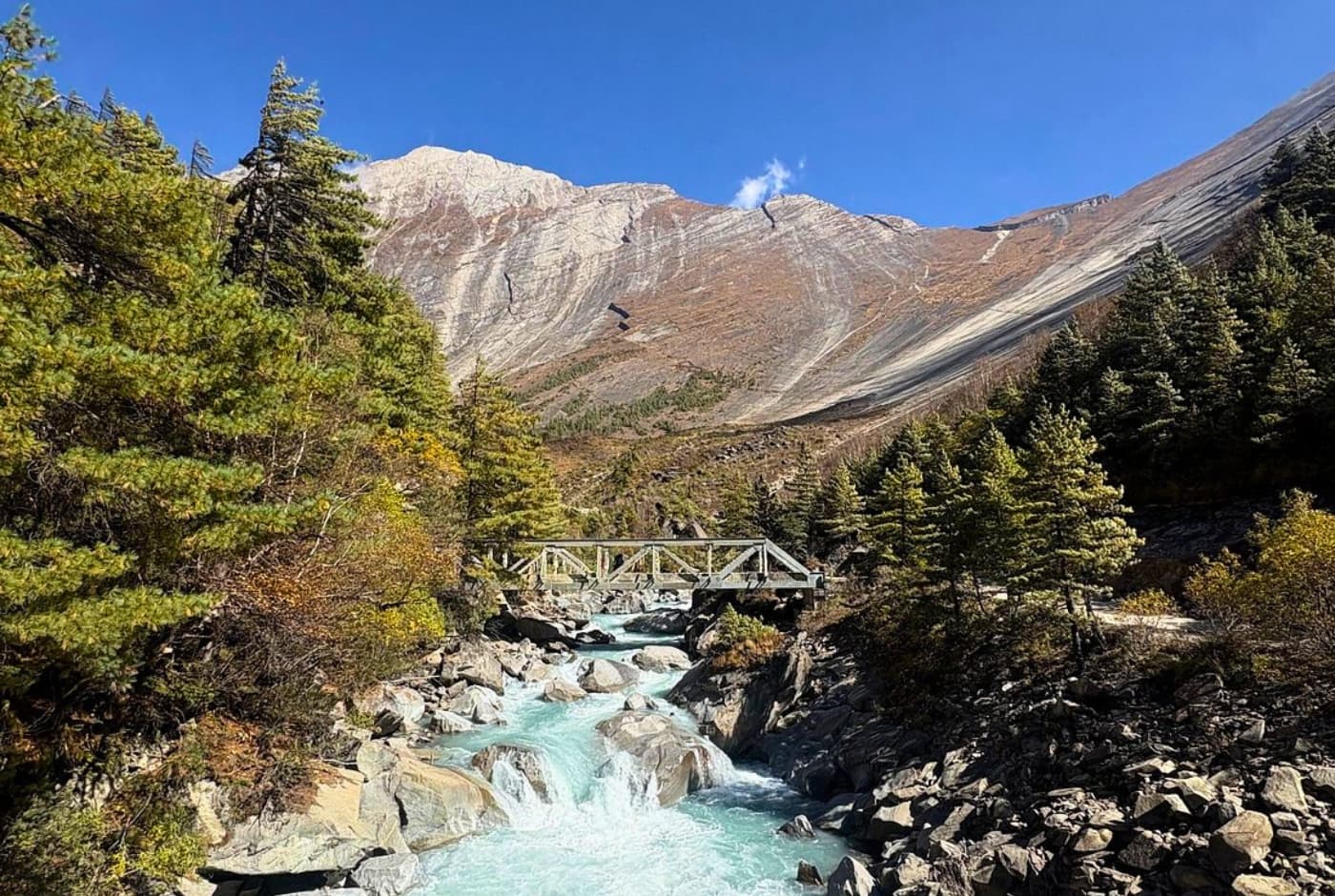
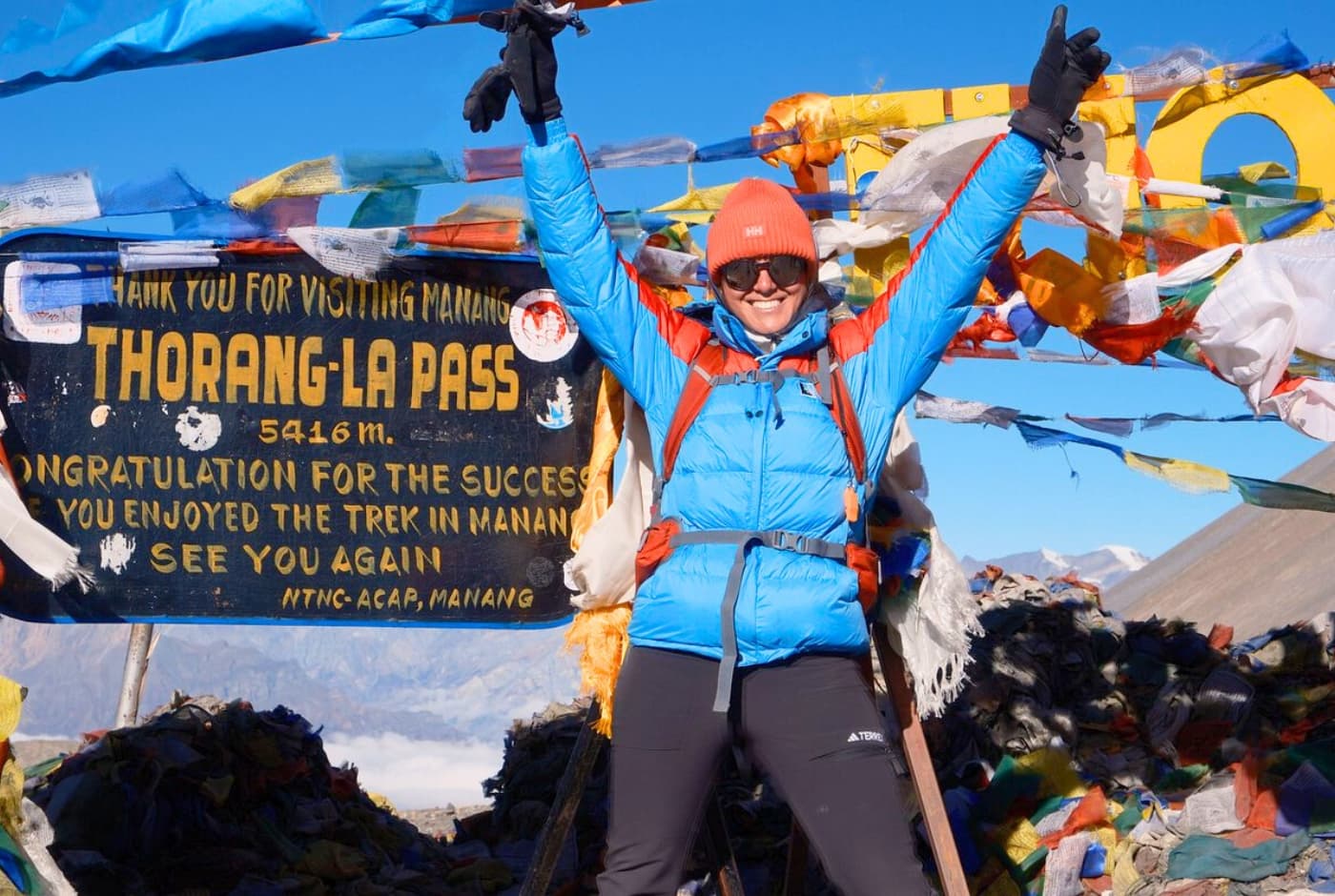
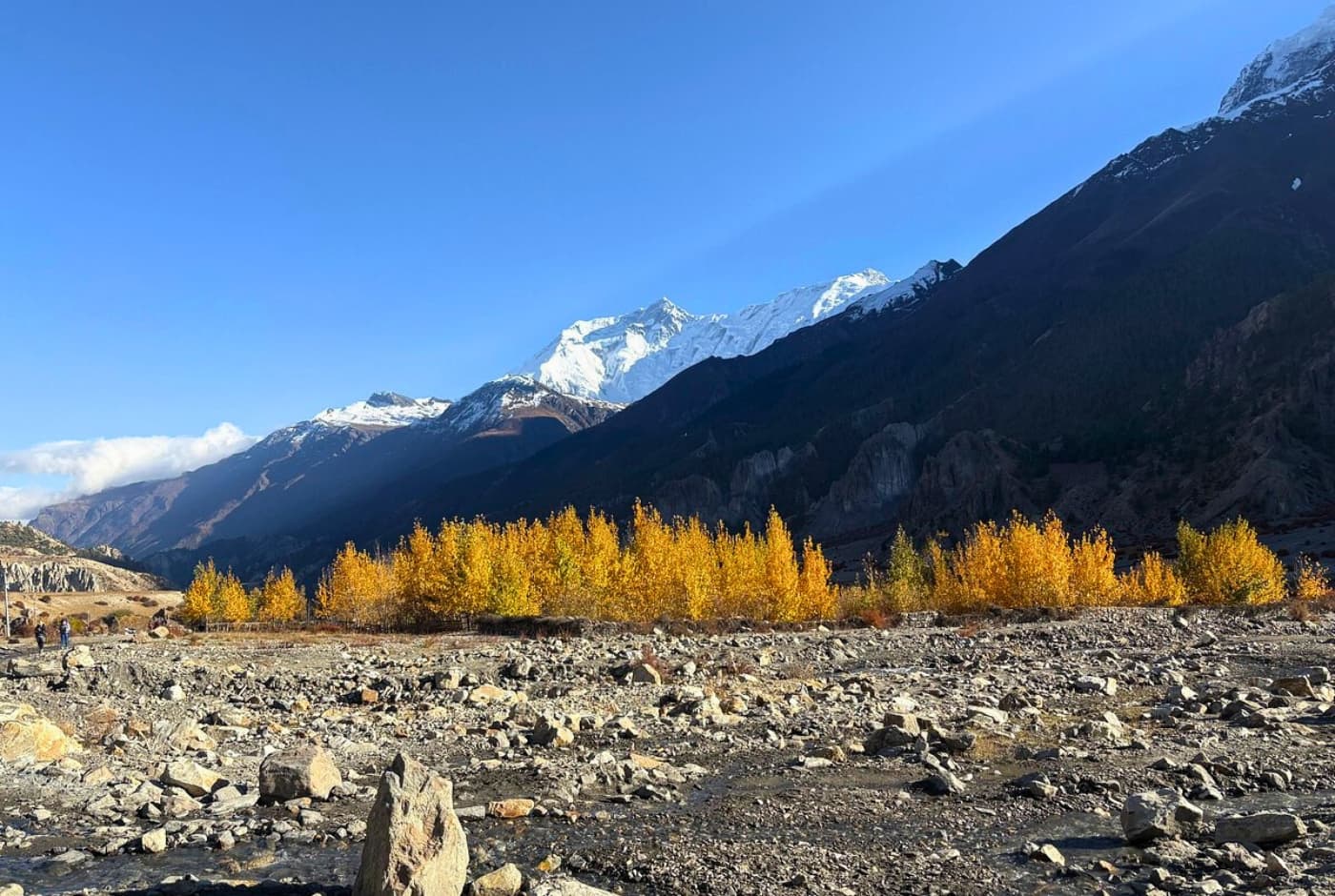
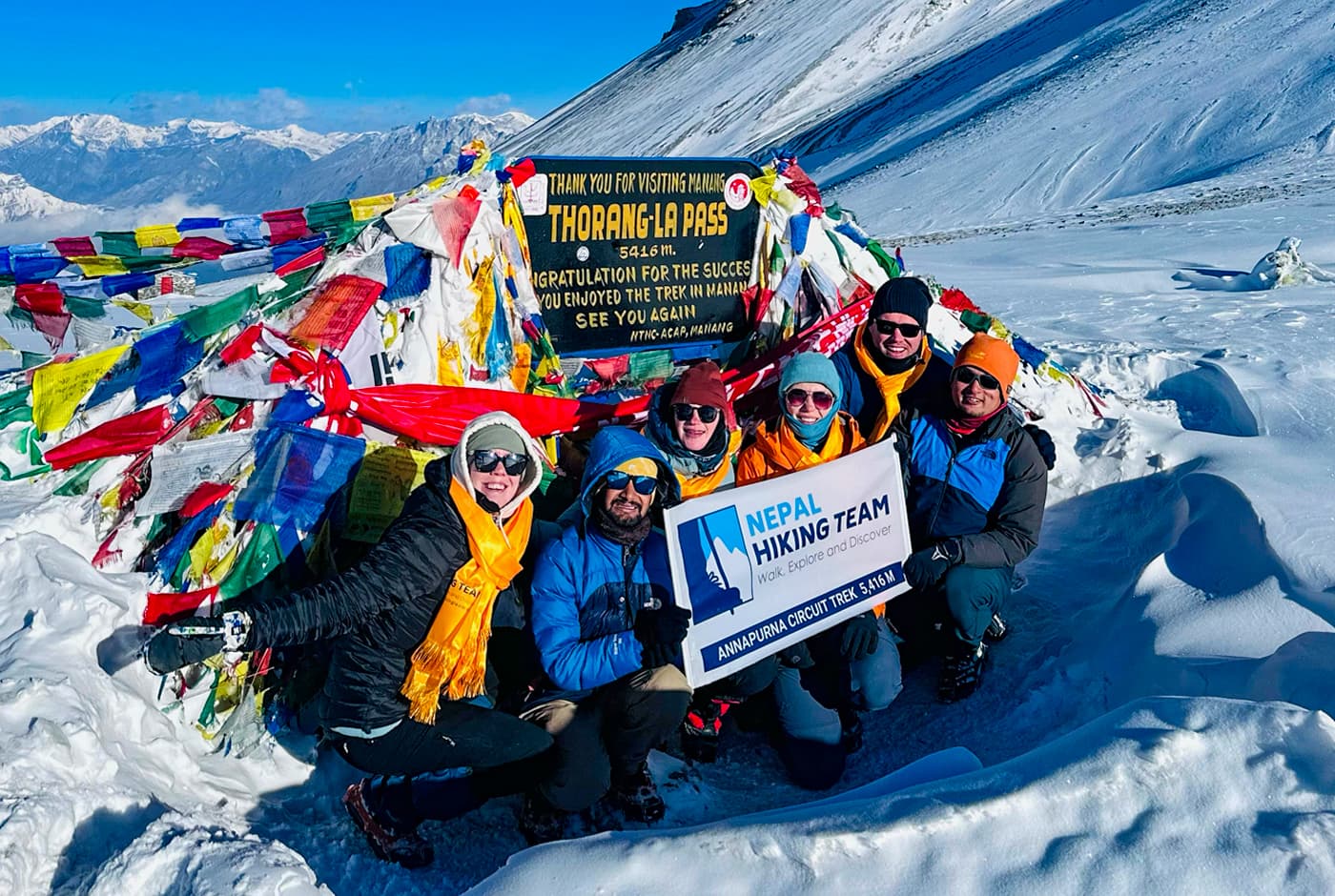
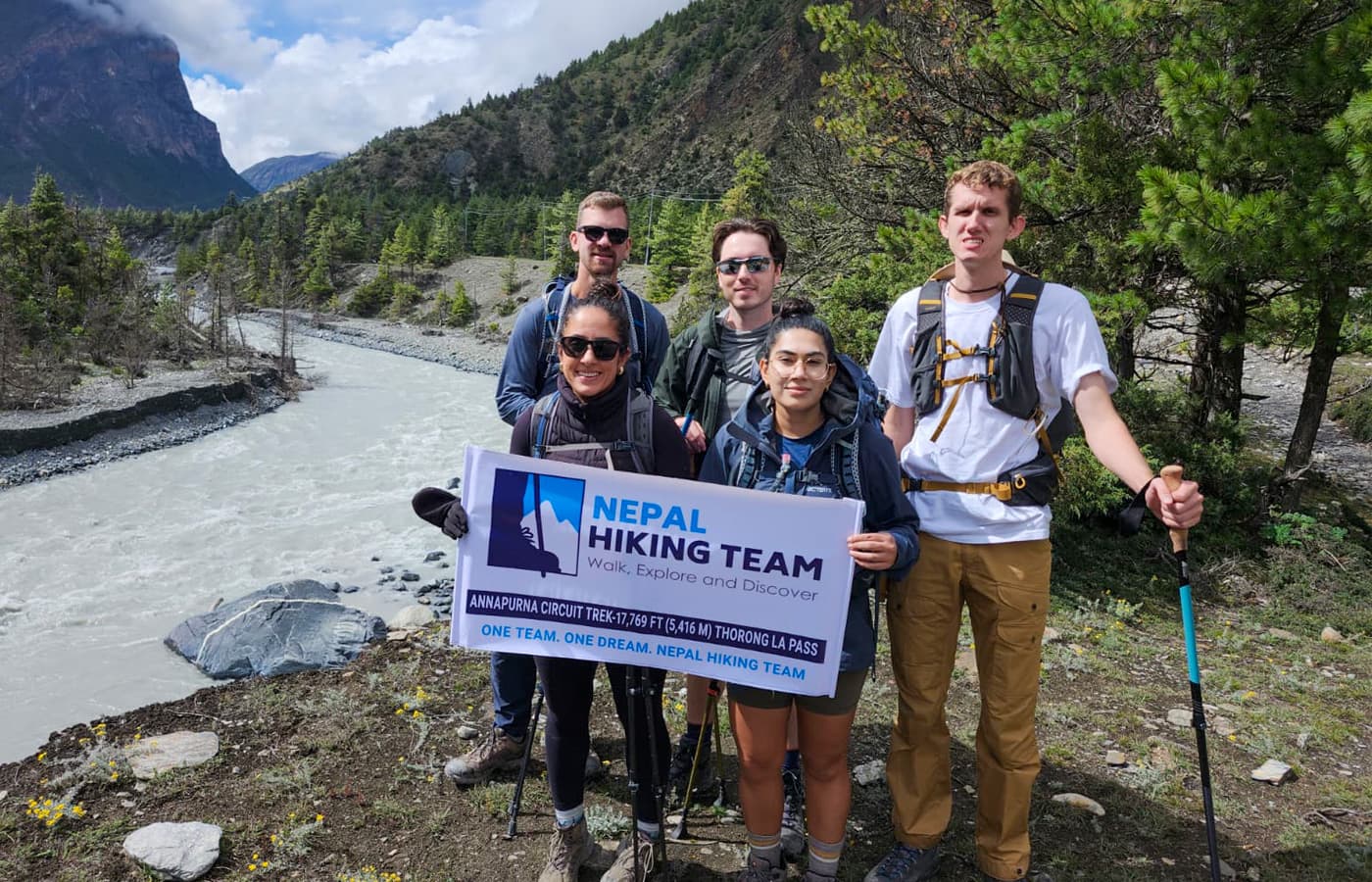
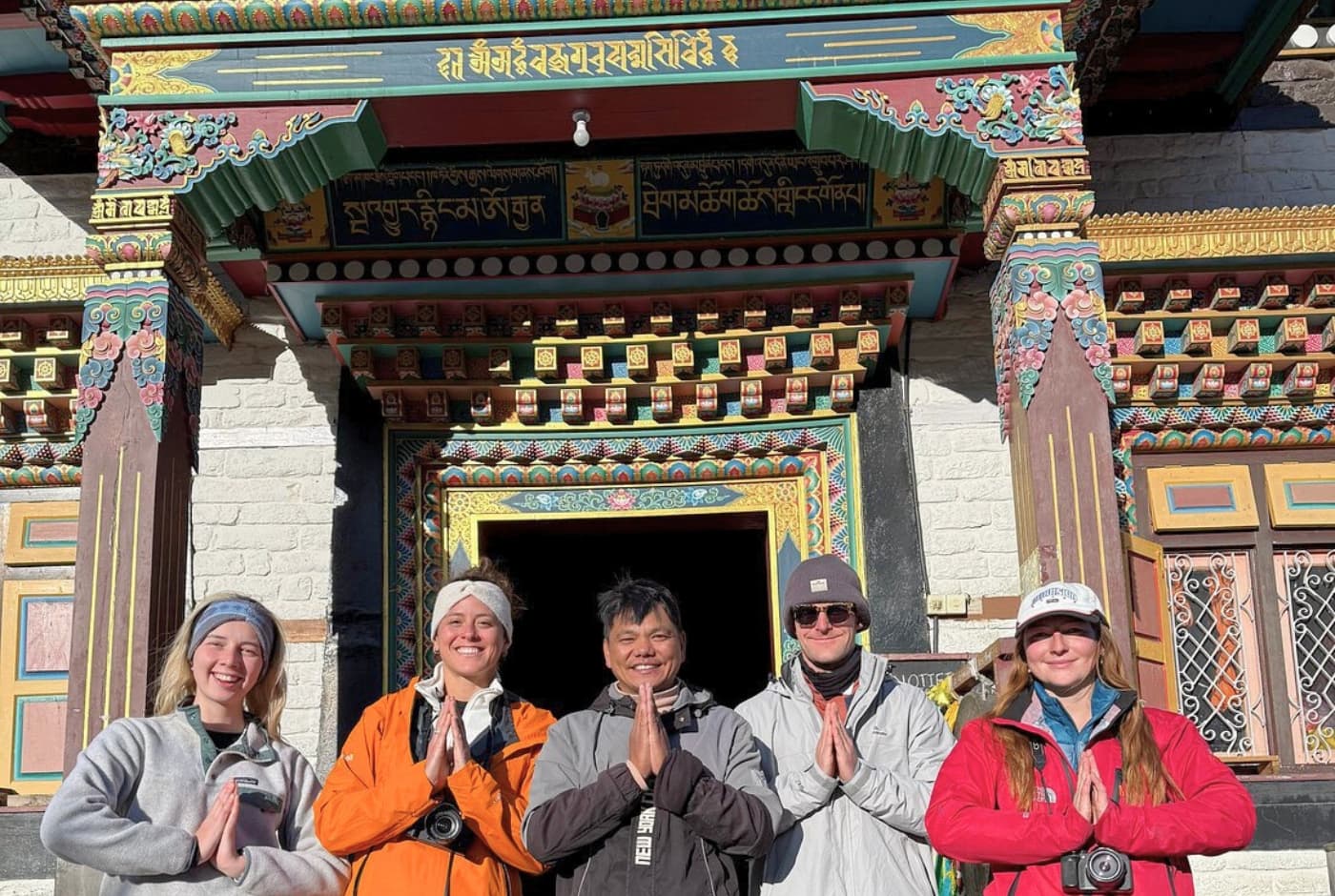
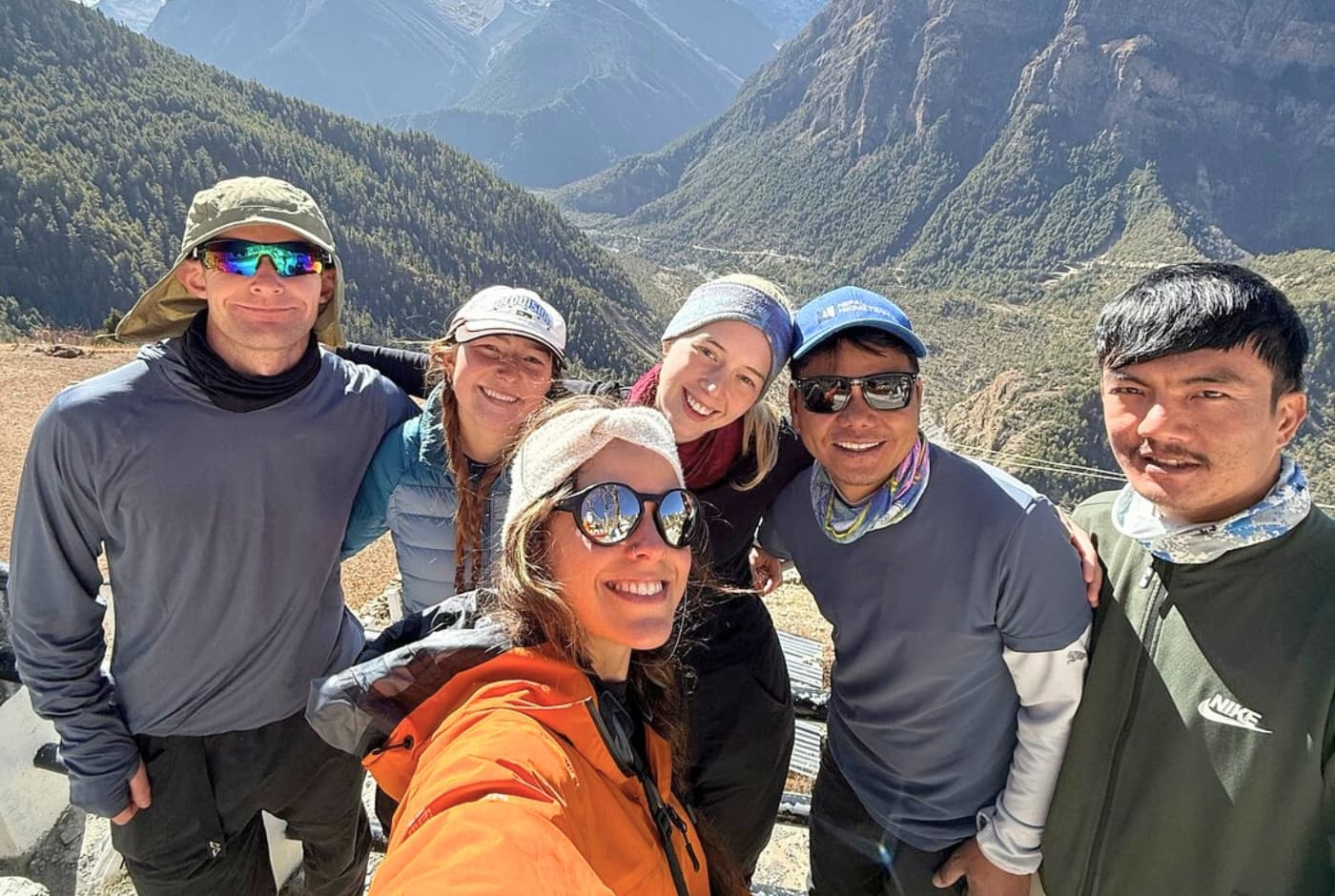
The Annapurna Circuit Trek is an indelible journey through the glorious Annapurna range. This adventure takes you through an incredible diversity of landscapes, including subtropical forests, river valleys, and high-altitude deserts and glacial terrain. The Annapurna Circuit Trek begins in Jagat and concludes in Jomsom. Trekkers can travel through the rich biodiversity of the Annapurna Conservation Area, home to a diverse range of flora and fauna.
The trek showcases Nepal's remarkable natural contrasts, leading you from the lush green forests of the Marshyangdi River Valley to the barren Kali Gandaki Valley. The circuit's highest point is Thorung La Pass at 5,416 meters. The Annapurna Circuit trek features daily walking sessions of 5-6 hours over nine glorious days, allowing for proper acclimatization while fully immersing oneself in the region's stunning mountain scenery.
The Annapurna Circuit trek offers a great cultural immersion through encounters with the warm and welcoming Gurung, Thakali, and Magar communities. You'll experience Nepal's rich heritage through Hindu and Tibetan settlements along the route, where smiling faces eagerly share their traditions and customs. This trek is ideal for adventurers seeking a remote mountain experience, offering a safe and well-supported journey from start to finish.
Your journey begins as you arrive at Tribhuvan International Airport, where you'll be taken to your hotel for rest. At the beginning of this 14-day trek, you will reach the starting point, Jagat (1300m), via road along the Marshyangdi River. From here, you will start among the top-rated long-distance trekking routes in Nepal.
The majestic views of the Annapurna range will greet you along the route as you make your way through Chame, Pisang, and other small settlements in between.
An extra day for acclimatization will be spent at Manang, where you can explore further destinations nearby such as Gangapurna Tal and the Milaerpa Cave. Ascent begins as you reach the grassy yak pastures of Yak Kharka (4,050m).
With a stop at Thorung Phedi, you will get the highest point of the circuit. Thorong La Pass at an altitude of 5,416 meters is one of the highest mountain passes in the world.
Then there’s a visit to the pilgrimage site Muktinath before reaching the beloved city of Jomsom. From this city, you will take a flight to the beautiful town of Pokhara. A final drive back to Kathmandu marks the end of this remarkable trip, which provides you immersive insight and experience of the Annapurna region.
Annapurna Circuit with Tilicho Lake Trek allows you to visit one of the highest lakes in the Himalayas. This alternative Annapurna Circuit Trek package includes hiking to Tilicho Lake and crossing Thorong La Pass. You’ll be taking the same route as the Annapurna Circuit, with an additional 2 days dedicated to visiting Tilicho Lake, making it a 16-day trek.
This package is ideal for adventurous spirits who want to cover the Annapurna Circuit but are short on time. The Annapurna Circuit Short Trek covers all the key highlights of the whole circuit trek. Still, it minimizes travel time by substituting one day of walking with a drive and the final drive from Pokhara to Kathmandu with a flight, finishing the trip in 12 days.
This 18-day trek follows the original route of Annapurna Circuit, passing through the local villages of Marpha, Ghasa, Tatopani, Ghorepani, and Banthati. A hot spring bath at Tatopani and a hike to Poon Hill from Ghorepani are nice additions available on this trip.
At Nepal Hiking Team, we offer a comprehensive Annapurna Circuit Trek in Nepal led by our trusted porters and experienced mountain guides. Our altitude-focused trek prioritizes your safety while adapting the pace to match individual comfort levels and acclimatization requirements.
Both group departure and private expedition receive our unwavering commitment to excellence. Through our 2025 Annapurna packages, we’ll continue to ensure that each trek becomes a secure, flexible, and significant mountain experience. For that, we take care of each aspect of reliable operational support and personalized attention.
Welcome to Nepal! A member of the Nepal Hiking Team will be waiting for your arrival at the Tribhuwan International Airport and transfer you to your hotel.
You can rest and prepare your body for the journey ahead, or explore the Kathmandu valley and the cultural diversity it has to offer.
Later, a representative from our team will brief you about the Annapurna Circuit trip and provide you with a duffel bag, T-shirt, and sun cap from the company. We also offer a down jacket and a sleeping jacket if needed. However, these items should be returned after the trek. Any further trekking gear and other essentials will be available for purchase or rent in Thamel.
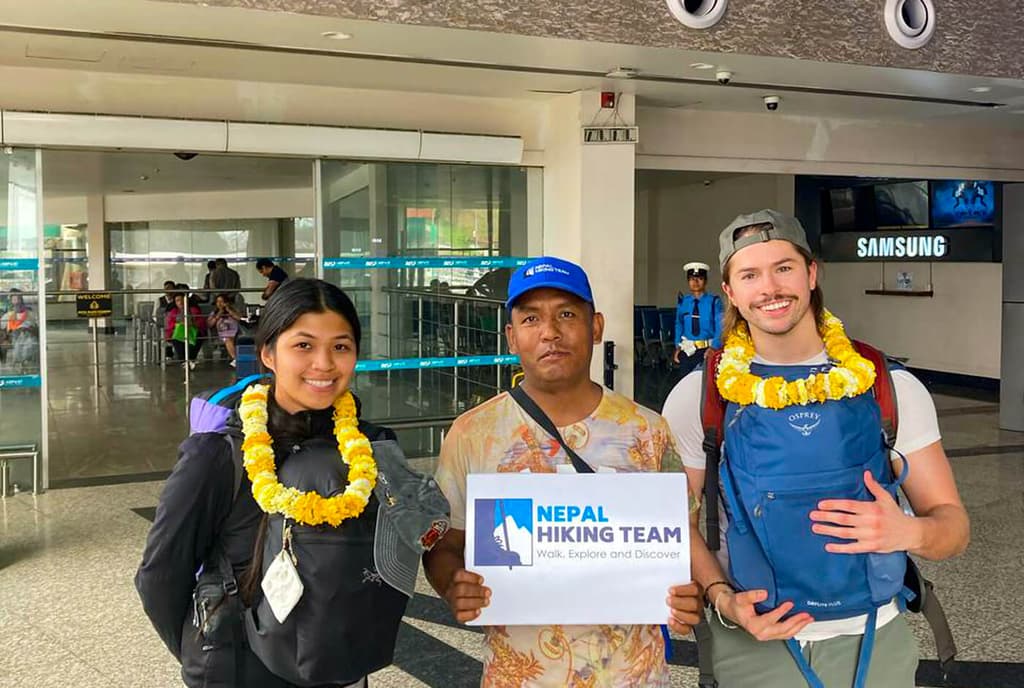
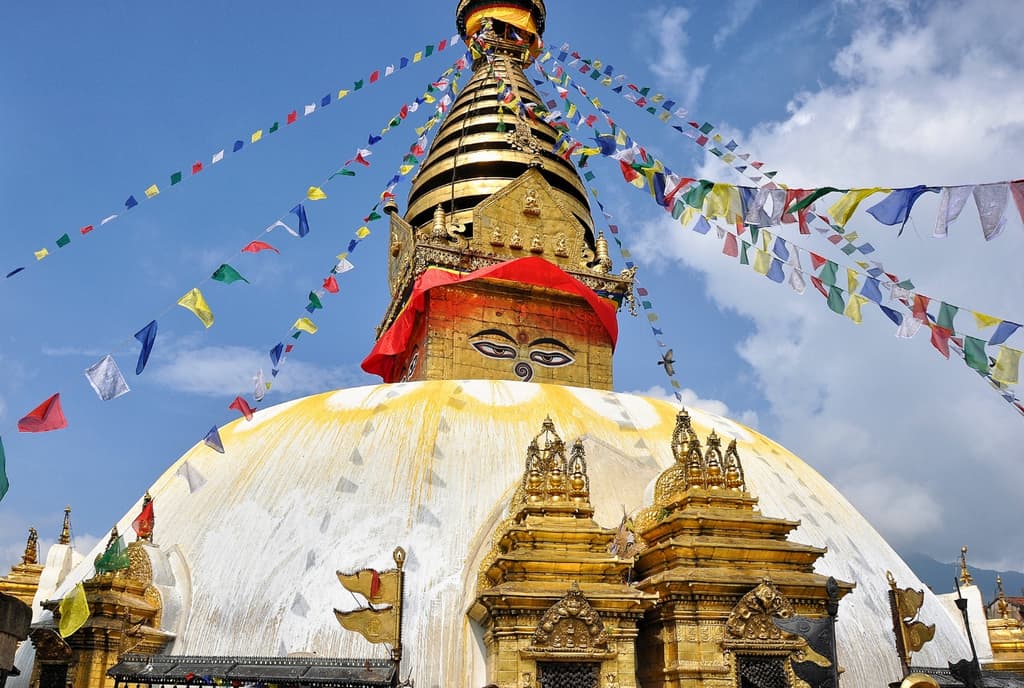
A 8-9 hour drive from Kathmandu will take you to the first stop of the trek at Jagat. You will drive down winding roads of Nepal’s green hills and reach Besisahar, a pleasant town in Lamjung district.
On the way, you will be following the flow of the Marshyangdi River as you pass by the small villages of Bhulbule, Ngadi, and Syange before finally arriving at Jagat.
This small riverside settlement offers numerous guesthouses and lodges, all ready to welcome you. Your guide will lead you to your chosen stay for the night.
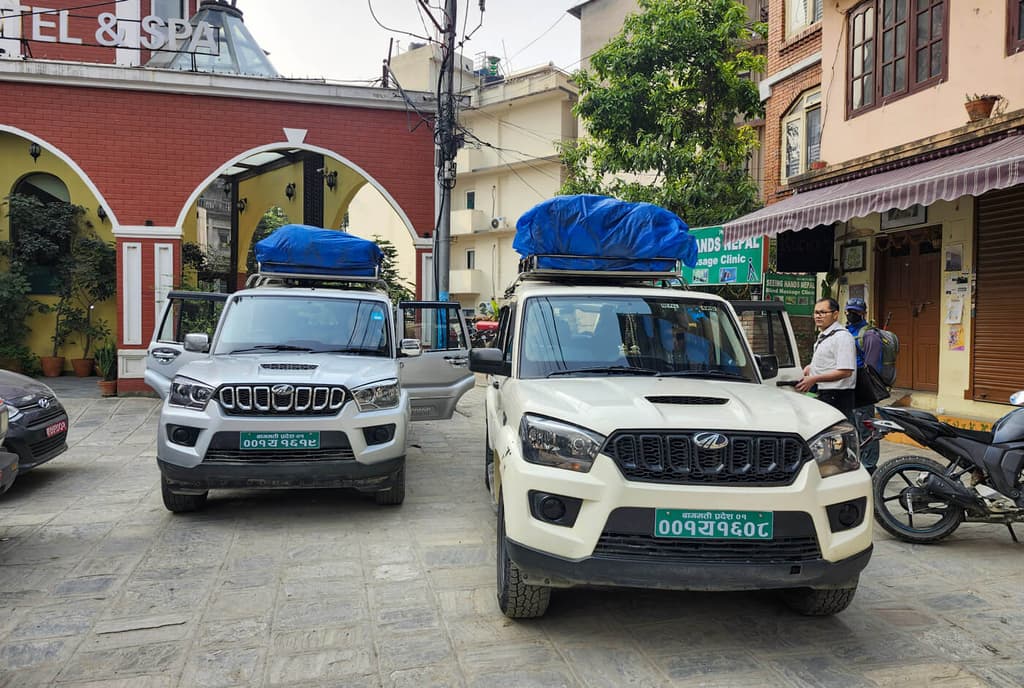
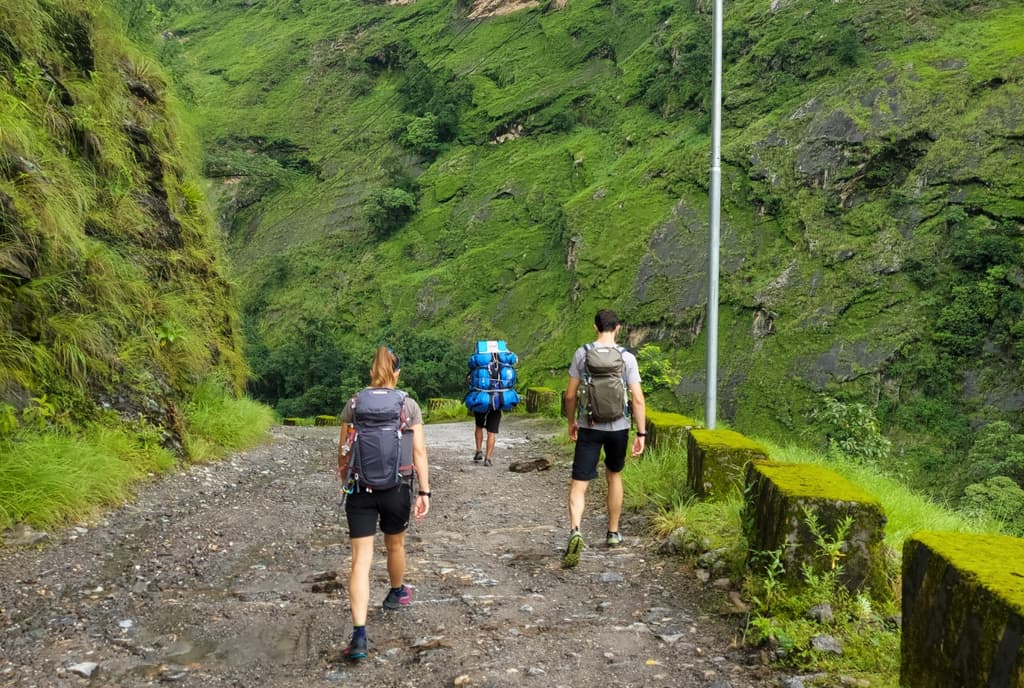
Now, your walk begins. You will cover approximately 14 kilometers on foot today in about 6 hours to reach Dharapani.
You can take one of two routes from Jagat to Dharapani: a steep walking trail with a long flight of stairs, or a flatter jeep track, which is comparatively more straightforward. The route will be chosen by your guide according to weather and other road conditions.
Navigating through rivers, waterfalls, suspension bridges, and gorges, you will reach the village of Tal, where your permits will be checked.
After you cross a few more small dwellings, such as Chamche and Karte, you will reach Dharapani (1860m). This village, marked by chortens and Mani walls, will be your home for the night.
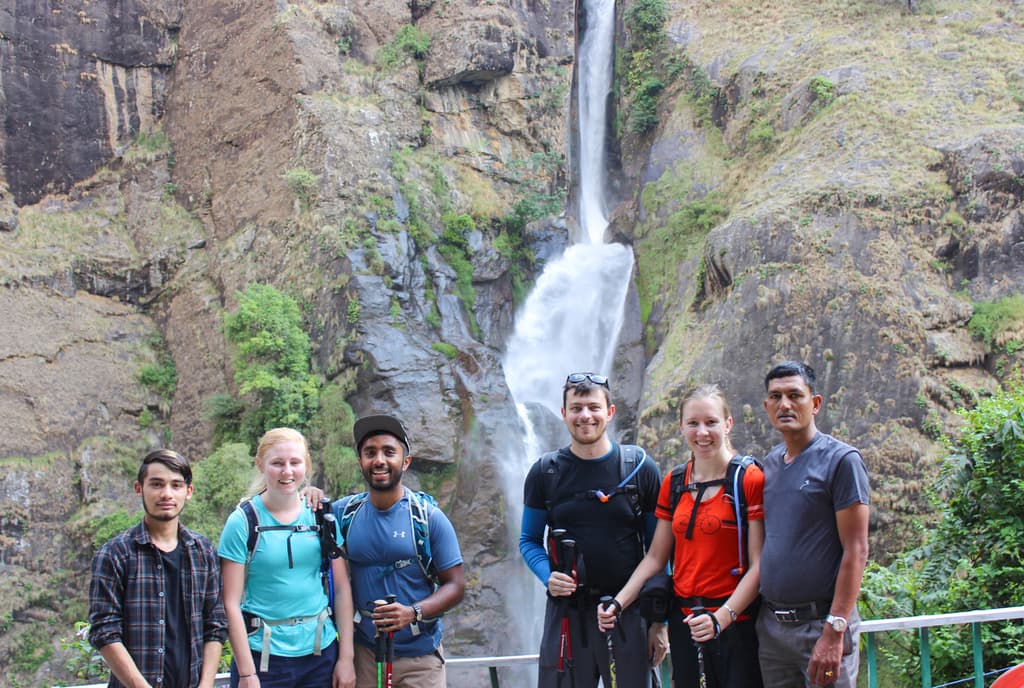
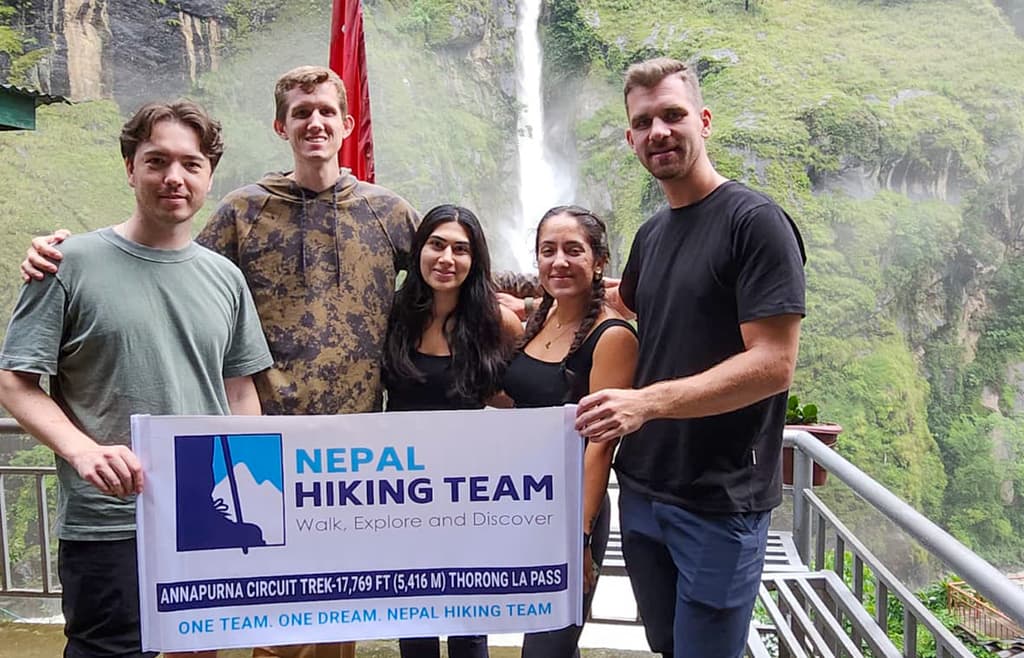
The journey picks up pace and brightens as you are greeted with the surreal view of Mt. Manaslu, Annapurna II, Lamjung Himal, and the Marshyangdi River on this day.
Lush forests and mighty waterfalls await you as you cover 15-16 km over 6 hours of walking. Starting immediately after breakfast, you will witness the lifestyle of the people in the small local villages of Thonche, Bagarchhap, and Danakyu.
The roads get steeper as you reach Timang village, cross the lush jungles of Lamatro, and the Buddhist village of Thanchok.
The biodiversity of Nepal will speak to you as you witness the change from greenery to sparse and bare slopes when you reach Koto village for a quick rest. At an elevation of 2670m, you will get to the largest town in the Annapurna Circuit, Chame, where you will spend the night.
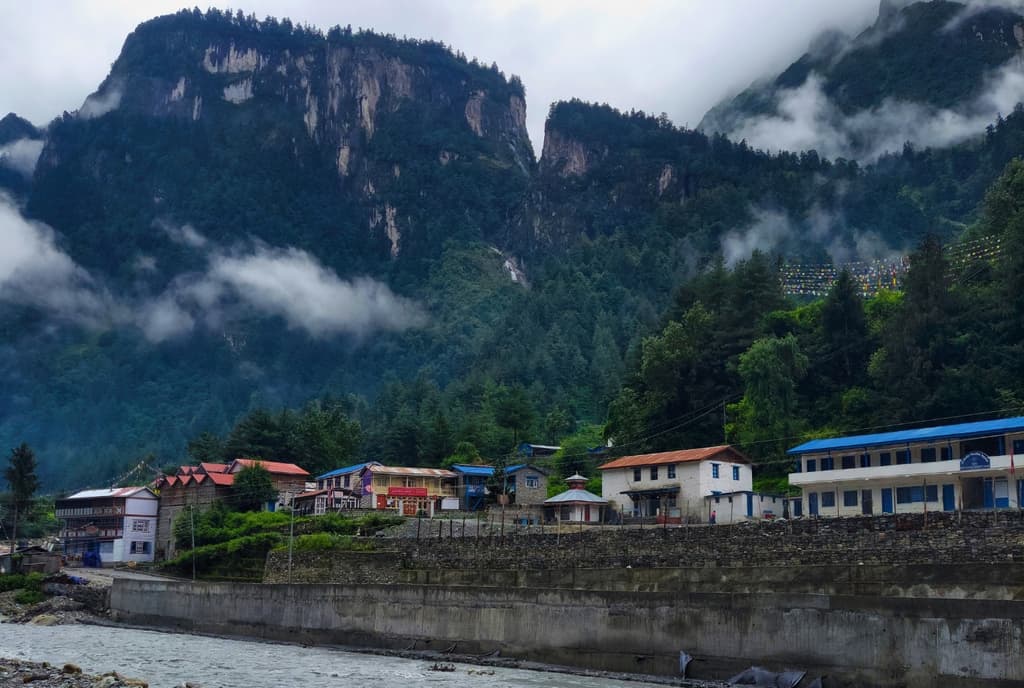
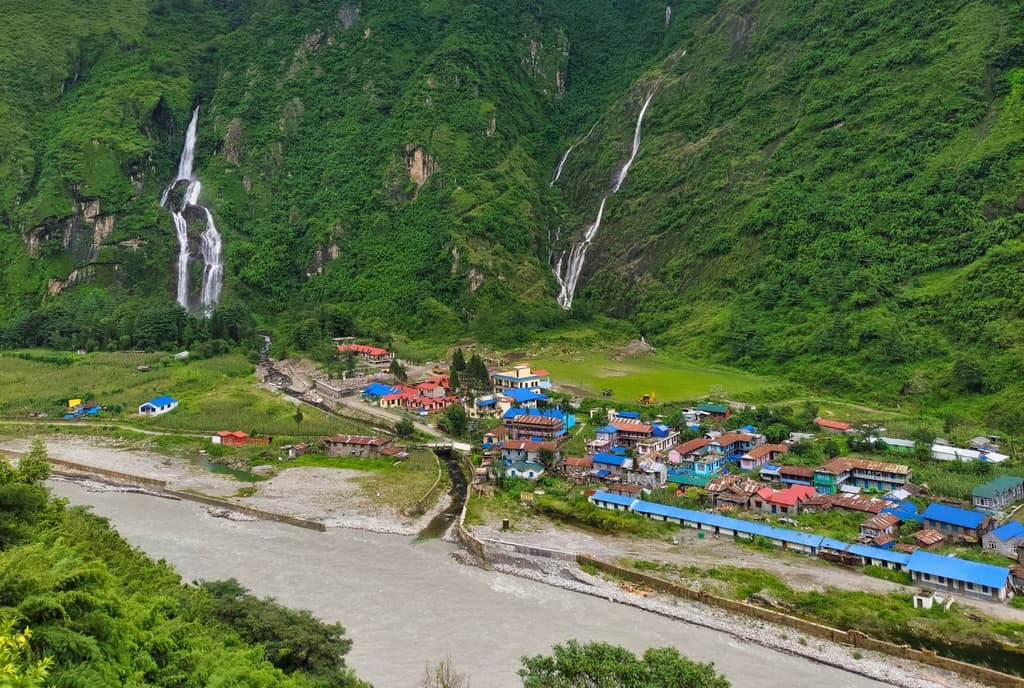
Exquisite views of the Lamjung Himal, Annapurna II, and Annapurna IV keep you going this day as you head out towards the suspension bridge over the Marsyangdi River after breakfast.
Taking in the view of the smooth slate face of the tall Paungda Danda, you will walk for an hour to reach the village of Barthang. Here lies the largest apple orchard in Nepal, with approximately 67,000 trees in the vicinity. Delicacies like apple pie, apple crumble, apple strudel, apple cider, etc., from the orchard will delight you.
Soon you will reach the Swargadwari Bridge and enter the U-shaped valley close to Dhukure Pokhari. You will see striking changes in the scenery here, with a sheer rock face above lush green valleys. The trail is fairly easy until Pisang, an ancient village divided into two parts: Lower Pisang and Upper Pisang.
Observing the Pisang Peak and the Mt. Annapurna ranges in Lower Pisang, a 30-40 minute hike will bring you to Upper Pisang.
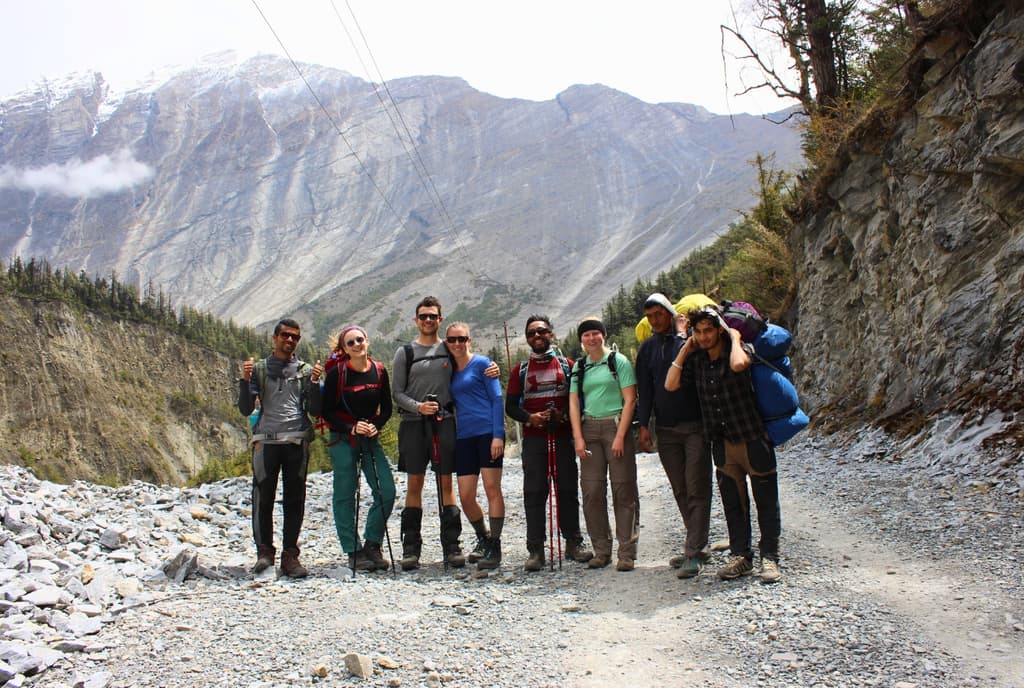
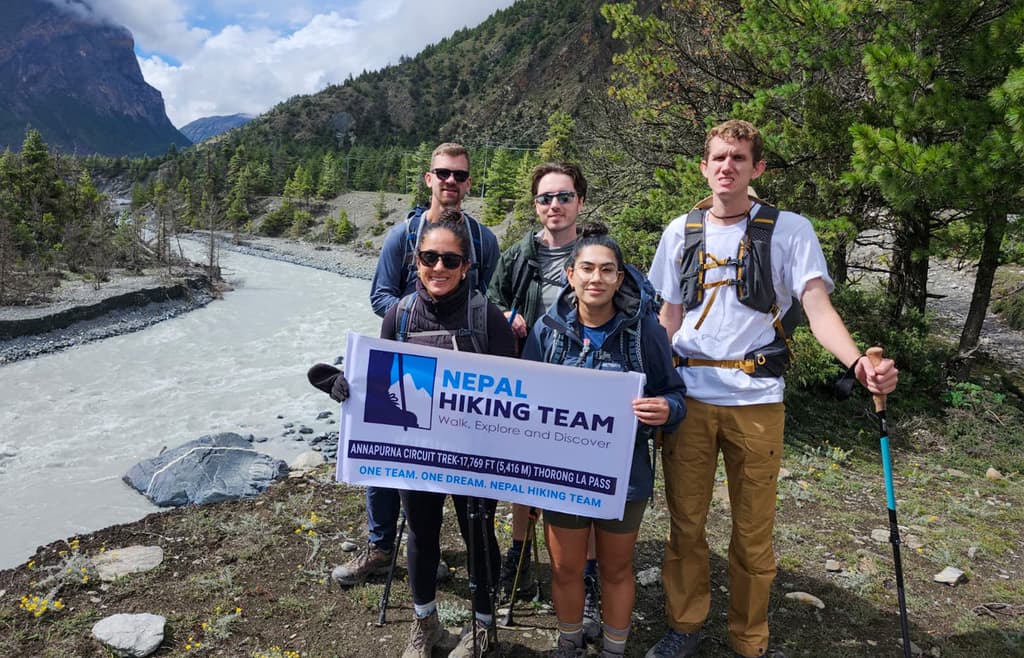
The route becomes steep and challenging, as you will be walking the longest on this day, approximately 5-6 hours. A 16km journey from Pisang will take you to the enchanting valley of Manang.
Hydration and warmth must be a priority, as the effects of altitude begin to take effect at this elevation.
A 2-3 hour climb on the higher trail, offering a closer view of Annapurna II and Annapurna III, will lead you to the authentic Tibetan-style village of Gyaru.
You will continue the uphill to Ngawal, after which the descent to yak pastures and alpine fields begins, transitioning to a drier, rockier terrain near Braka. Here, you will have a short break and get a chance to visit the centuries-old Samgag Samling Monastery, surrounded by unique village houses.
In the final stretch, you make your way to Manang, where the Annapurna peak, Gangapurna, and Tilicho Peak stand tall to welcome you after a strenuous day. You will find more facilities in Manang as it is the largest and busiest village on the route.
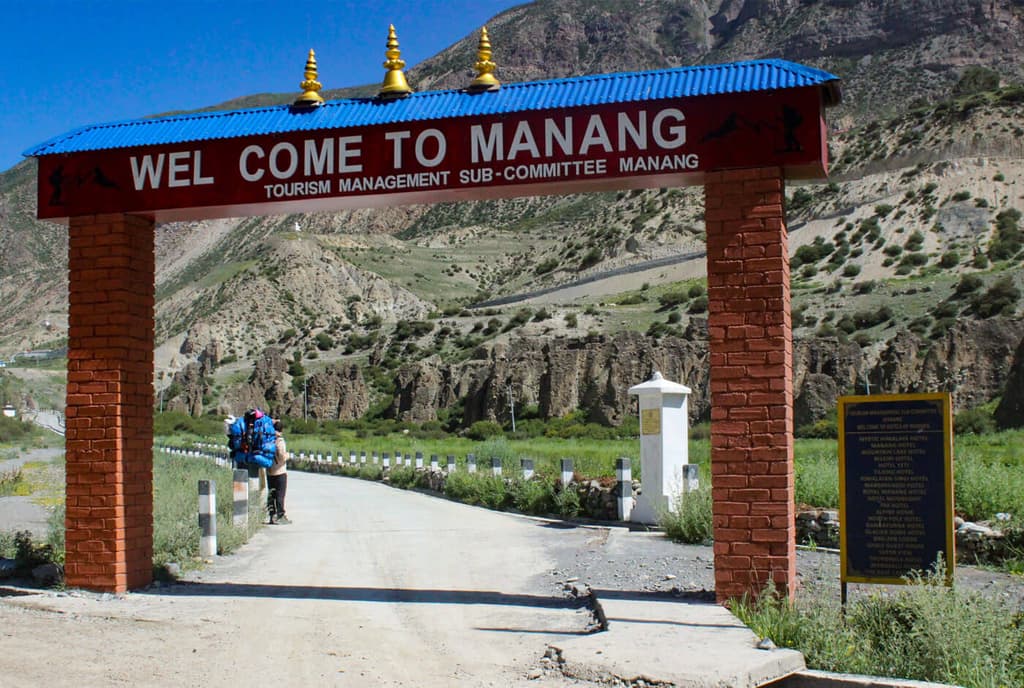
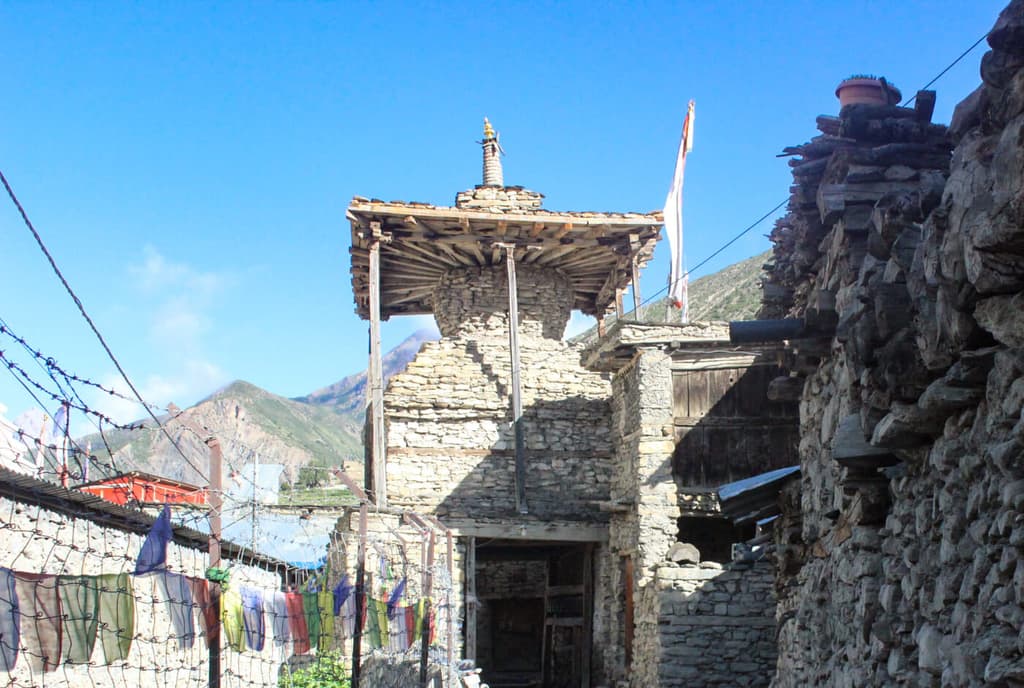
After 4 days of walking, you deserve some much-needed rest. A dedicated acclimatization day at Manang will do the trick and help you get used to the altitude.
Manang has a lot more to offer for resting trekkers as well. A short and easy hike to Ganggapurna Tal, a beautiful freshwater lake formed by the Ganggapurna Glacier and Peak, will freshen you up.
If you are looking for something more adventurous, you can opt for a more strenuous hike to Milarepa Cave, where the Buddhist saint Milarepa meditated.
Nonetheless, the hospitality of Manang is sure to win your heart. Use this time to interact with the locals to know more about their culture and lifestyle while leisurely walking through narrow alleyways and flat-roofed stone houses. Spend the night here gathering enough rest for the journey ahead.
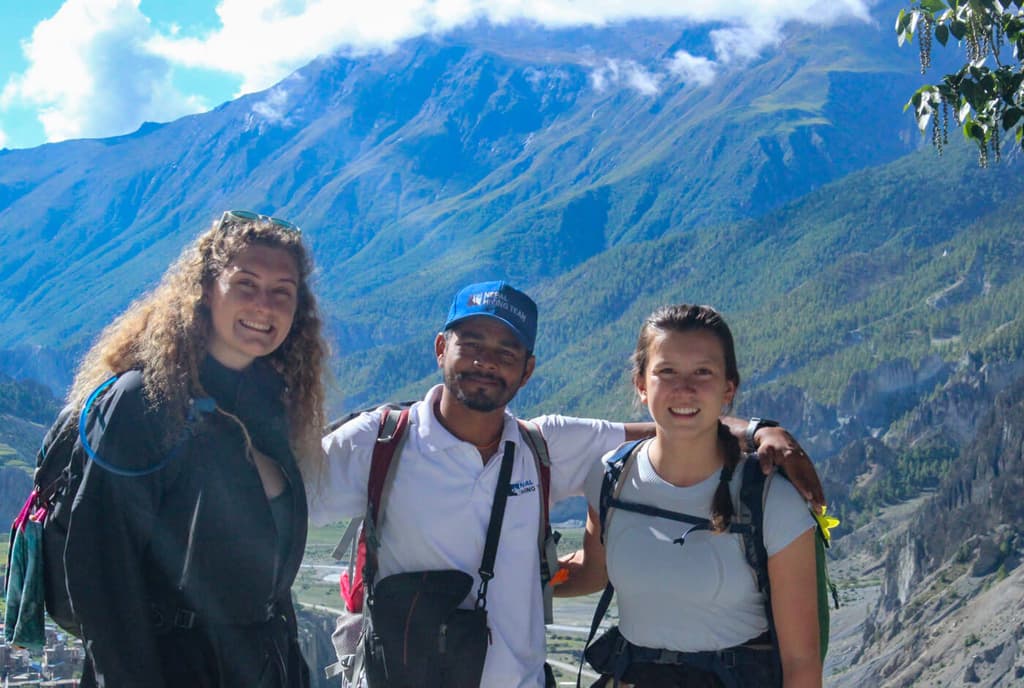
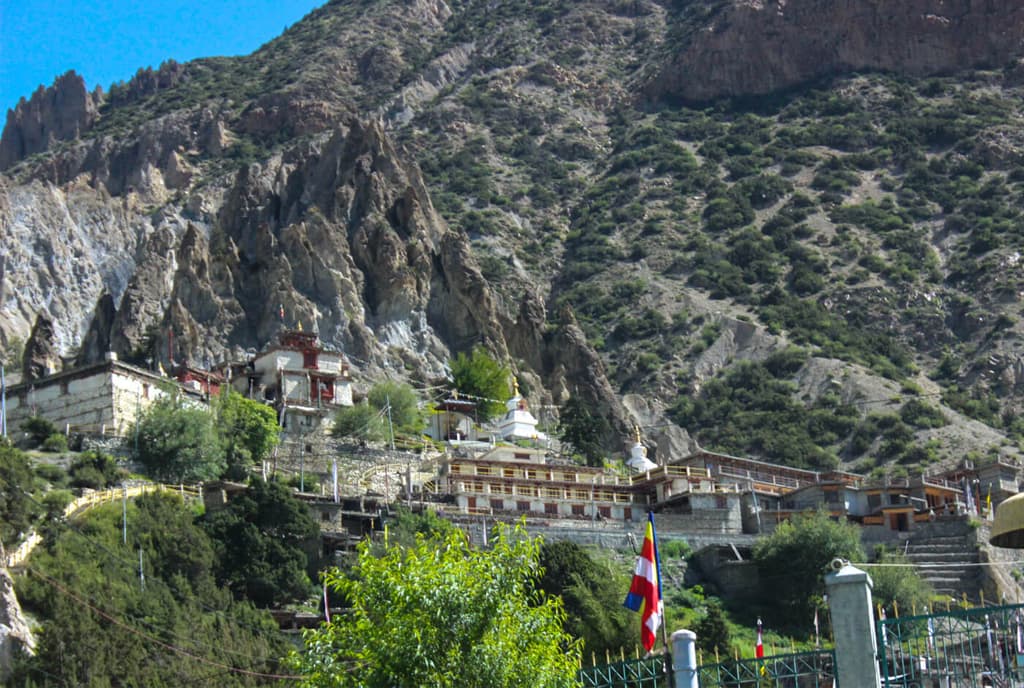
Bidding goodbye to lovely Manang, you begin your relatively short walk of 3-4 hours today. The close-up view of Annapurna keeps you in awe as you ascend into a more peaceful trail, leaving the dirt road behind.
After you slowly walk past the Tengi village, you will notice vegetation getting scarcer as you approach Gunsang. You will follow the glistening Marshyangdi Khola, enjoying the brilliant Chulu West and Chulu East as you gain elevation. A steady pace, rest stops, and hydration will keep you going. A wooden bridge crossing later, you will reach the yak pastures of Yak Kharka, marking 11km covered.
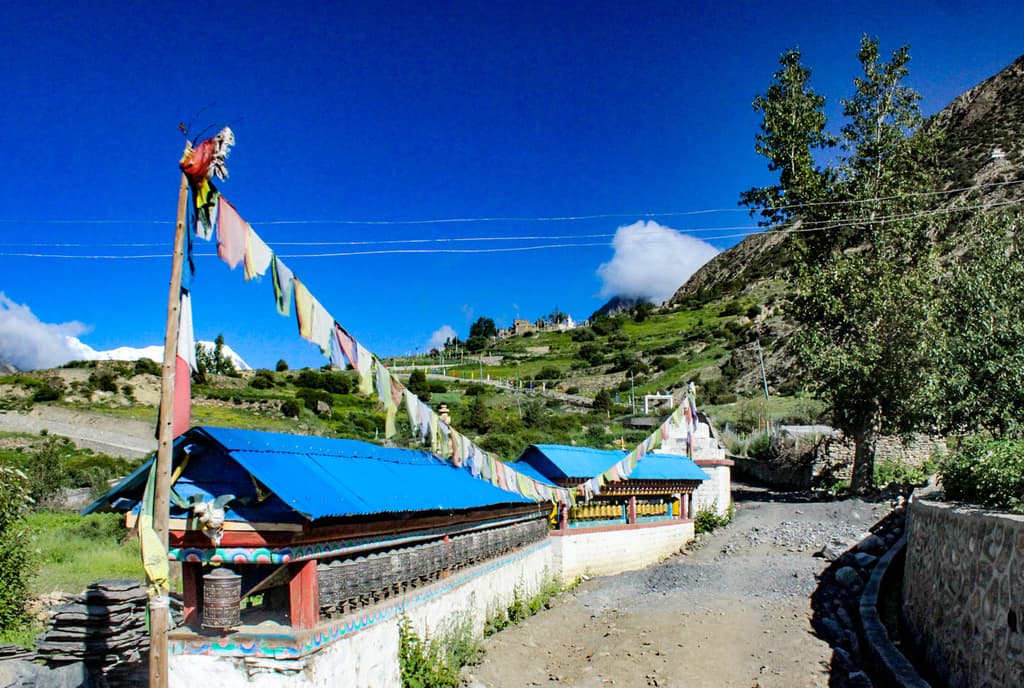
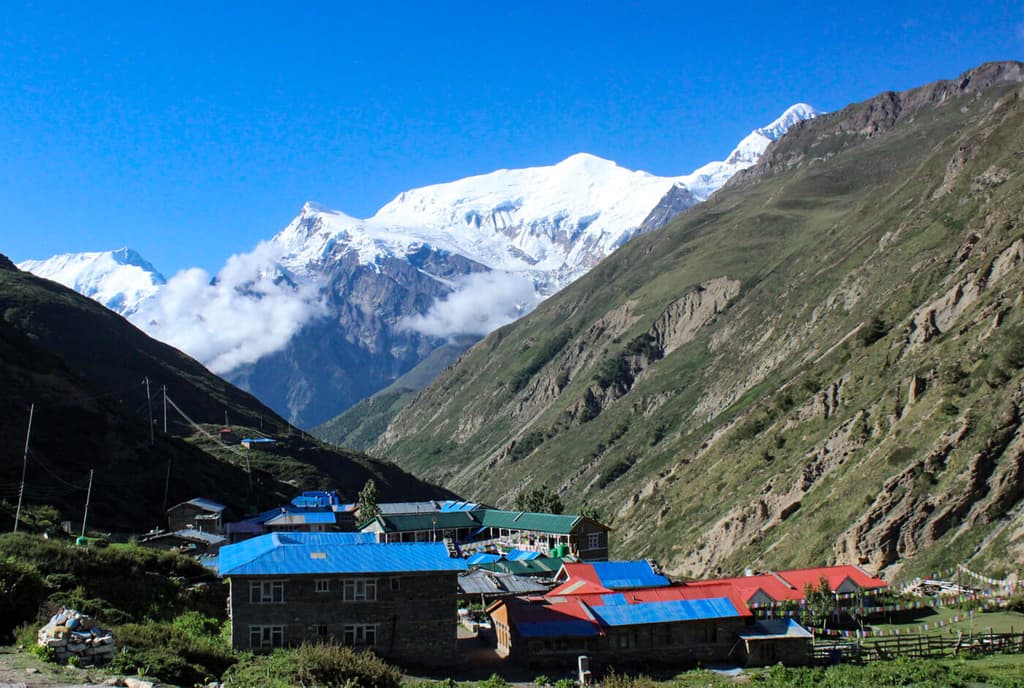
You will take on the shortest trek of the journey from Yak Kharka to Thorong Phedi today. After a slight uphill along Kone Khola, you will find yourself at Ledar in one hour, where your permits will be checked.
You will walk past tea shops at Deurali and a newly built metal bridge over the Jarsang Khola before reaching Thorung Phedi, which will be the final resting spot before you go for the big ascent.
Although you can expect to complete this trek in 4 hours, the high altitude and elevation add to the challenge and thrill factor. Caution is advised when you cross the landslide-prone zone in this narrow trail.
However, if you want, you can choose to continue your hike up to Thorung High Camp, which makes the following day’s journey more convenient. Situated about 300 to 400 meters higher than Thorong Phedi, the hike to High Camp typically takes around 1 to 1.5 hours.
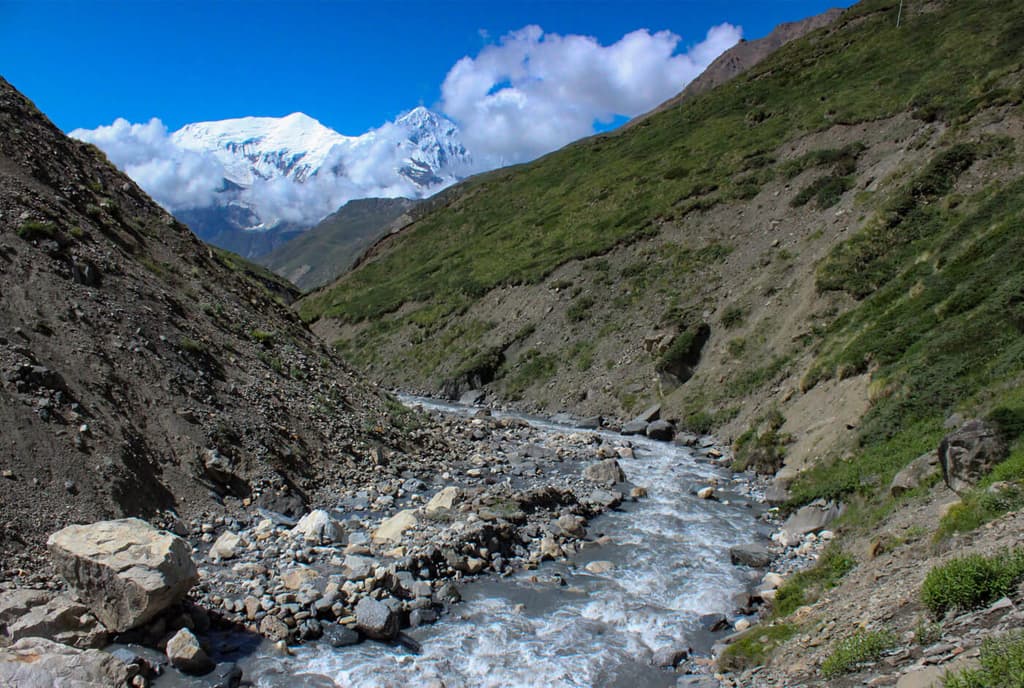
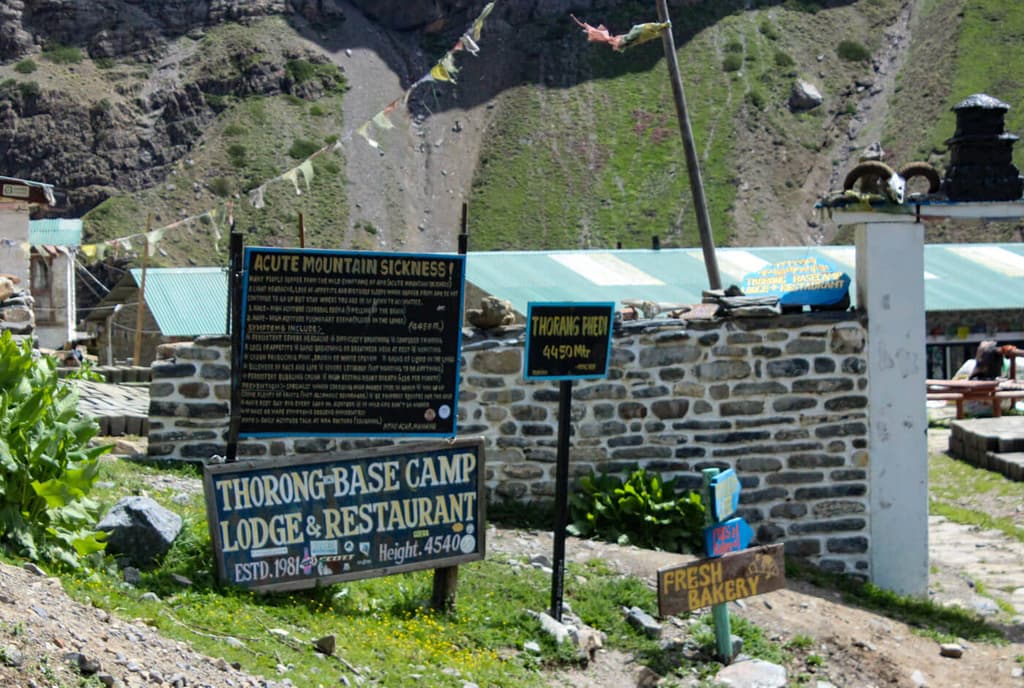
The day of the conquest is here. For a safe and feasible journey, you will start the walk at the crack of dawn, at 4:30 am, to avoid the strong winds and cold.
Rocky terrain, steep slopes, and snow challenge your legs, and your body is trying to cope with the thin air at this altitude. Be sure to walk slowly, take breaks, and keep hydrated to avoid strain. After about 1–2 hours, your spirits will be recharged when you reach High Camp and meet the scenic views of Thorung Peak, Khatungkang, and Yakawa Kang. There are many switchbacks, and the false summits and high altitude make the hike challenging.
As you push through 3-4 hours of uphill climb, you will be living the moment you’ve been waiting for at Thorong La Pass. The highest point of the Annapurna Circuit, located at a staggering 5,416 meters, is adorned with prayer flags, shrines, and other spiritual items. The rigorous journey will be worth it when you witness Annapurna in its full glory, along with the stunning Great Barrier Ridge that separates the drier Tibet-like region of Manang from the rest of Nepal.
This grand feat calls for celebrations and numerous photos, after which you will begin your descent to Muktinath.
The most significant part of the challenge is completed, but it’s not over. The peaceful yet arduous trail will take you through the Thorung Khola route, passing Chambar Bhir with beautiful views of the Kali Gandaki Valley and Dhaulagiri, the seventh-highest peak in the world.
Finally, you will arrive at the religious tourism destination of Muktinath. You will spend the night here, tired and with goosebumps, remembering the day’s achievement.
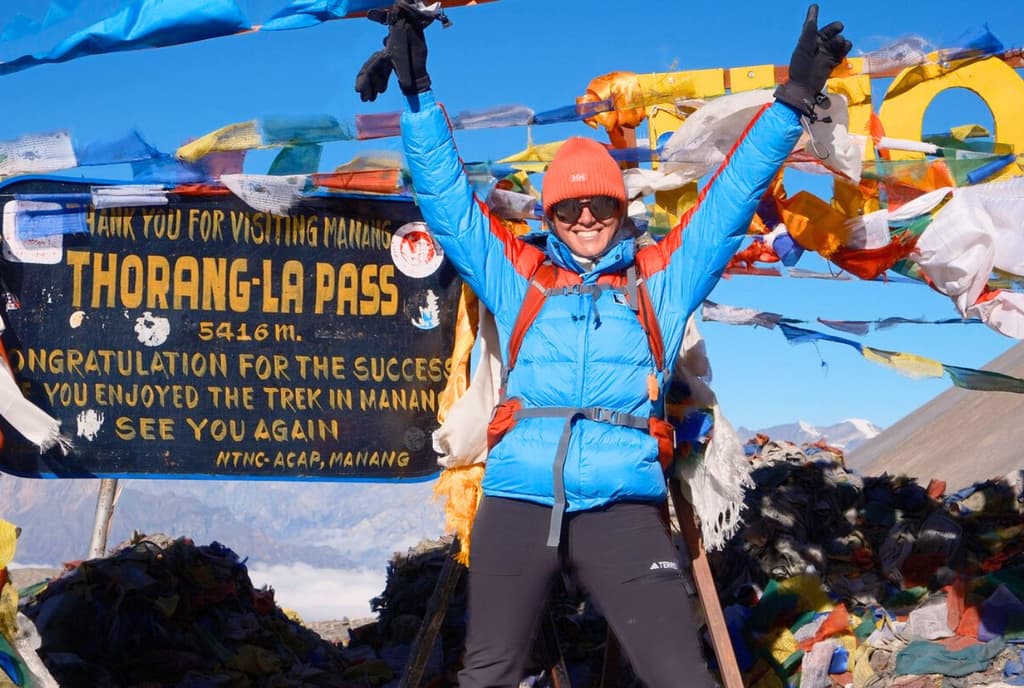
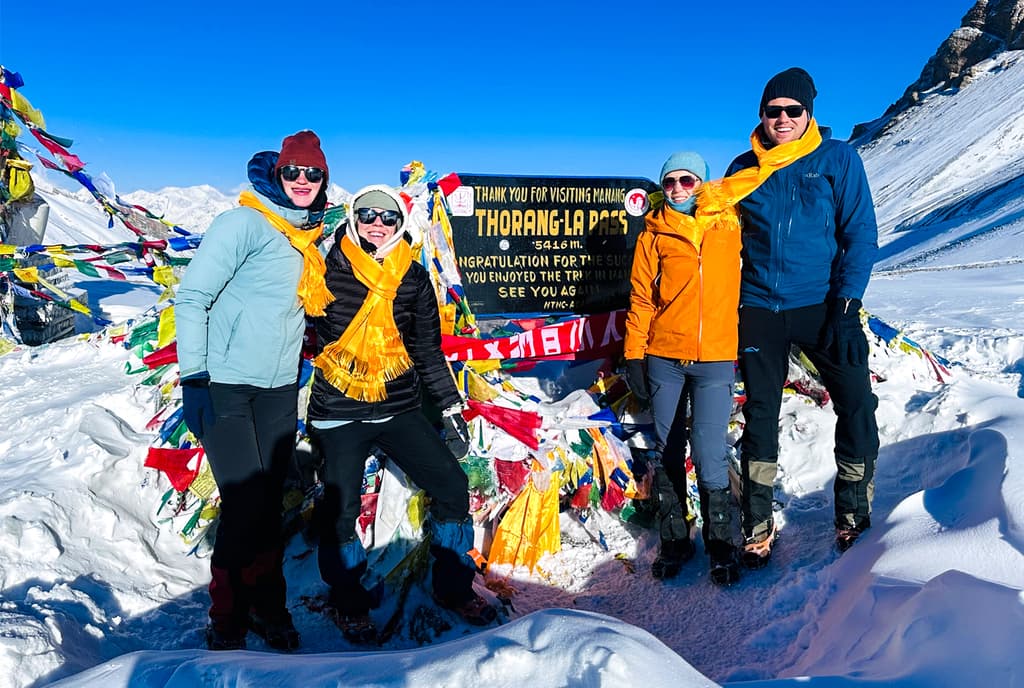
Now that elevations have dropped, you will feel much better.
You’ll have a spiritual start to your day by visiting the sacred Muktinath Temple. This holy pilgrimage site is extremely popular among Hindus and Buddhists, and it is also known as the home to the eternal flame and 108 holy water taps. The temple is dedicated to the Hindu god Vishnu, who is recognized as Chenrizeg or Avalokiteshwara by Buddhists.
You will observe devotees practicing spiritual cleansing by taking a bath in the icy cold water running from the water taps.
The journey will proceed as you walk to Jharkot, where you can visit the Shakya Gompa. The mountains will still be with you when you gradually descend to the Kali Gandaki River and see the peaks of Dhaulagiri and Nilgiri.
A 3-4 hour walk will take you to the ancient city of Kagbeni, which holds religious significance for both Hindus and Buddhists. The closely packed mud houses, dark tunnels, and alleys will give you a medieval village experience.
Walking past Kagbeni and the small dwelling of Ekle Bhatti, you will arrive at the ending point of the Annapurna Circuit Trek in Jomsom, home to the Thakali community. It is the largest town on the Annapurna Circuit and will be your last resting point in the lap of the mountains before you head back to the city.
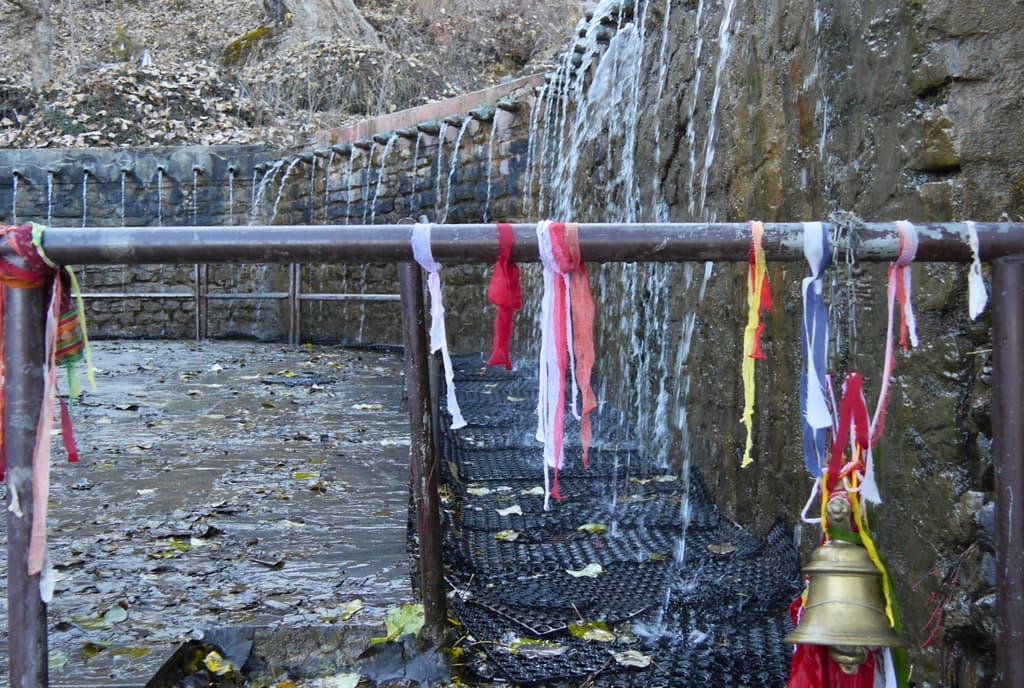
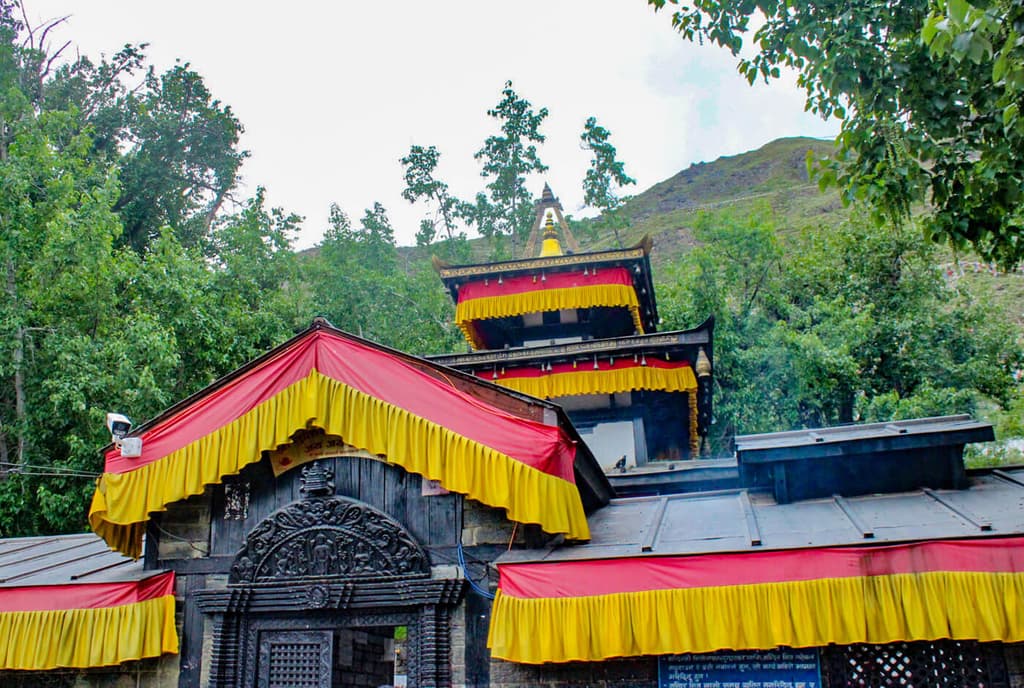
Congratulations, you have completed one of the most scenic trekking routes! The challenge has ended, and now it's time to relax.
In this Annapurna Circuit Trek, you’ll fly from Jomsom airport to Pokhara, enjoying the mountain ranges. After landing, you will be driven to your hotel, after which you can have some much-needed rest or explore the vibrant lakeside on your own.
Note: The Jomsom to Pokhara flights are often delayed or canceled due to bad weather conditions. If these conditions arise, you can return to Pokhara in a vehicle. The drive takes approximately 5 hours. The overland route takes you past the villages of Marpha, Ghasa, Tatopani, and Beni.
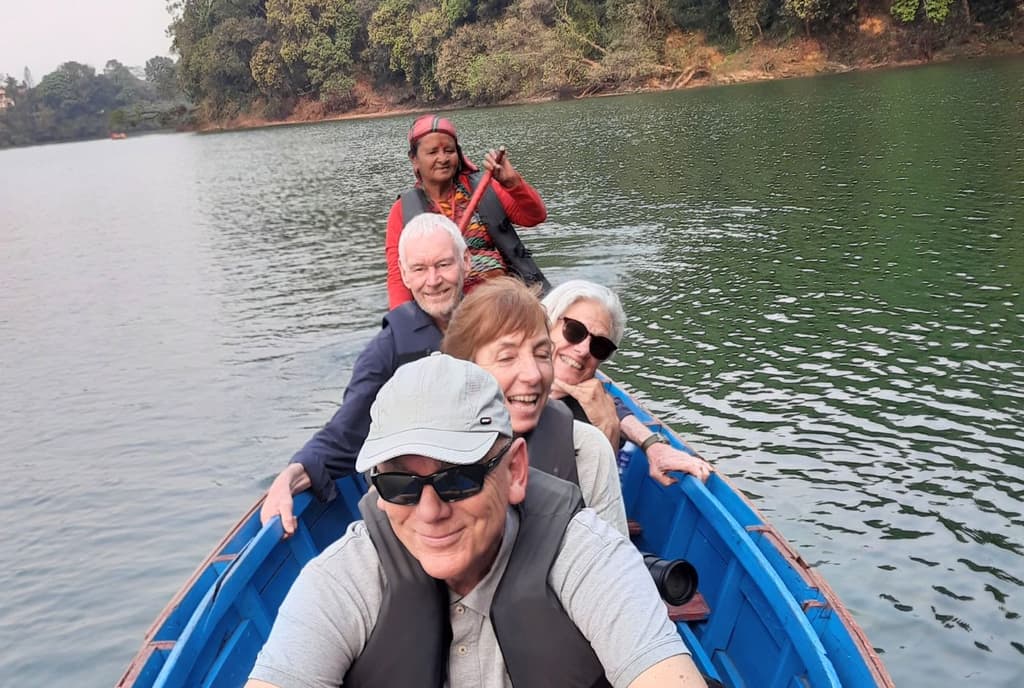
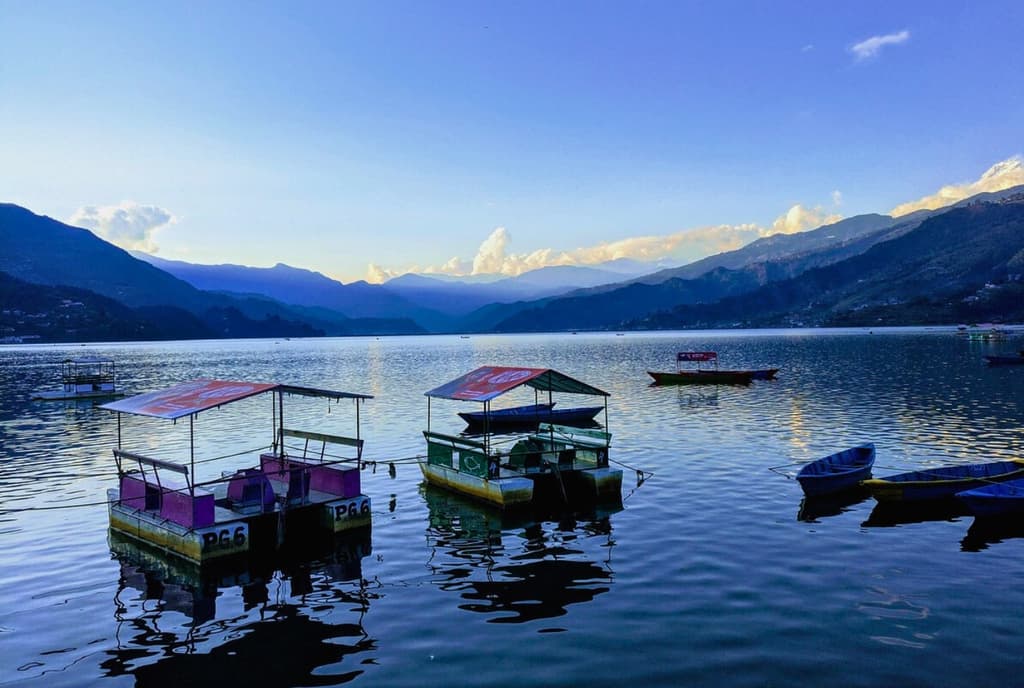
You will be taking a 7-8 hour bus from Pokhara to Kathmandu. You will be dropped off at your hotel, and then you can enjoy your free time exploring the streets of Thamel, shopping, discovering local eateries, and more.
You’ll spend the last night of your trip in Kathmandu.
Note: We can arrange a flight to Kathmandu for you at an extra cost if you are too tired to take the long journey by bus. A flight ticket for Kathmandu from Pokhara is 115 USD. You can reach Kathmandu more conveniently by paying this additional fee.
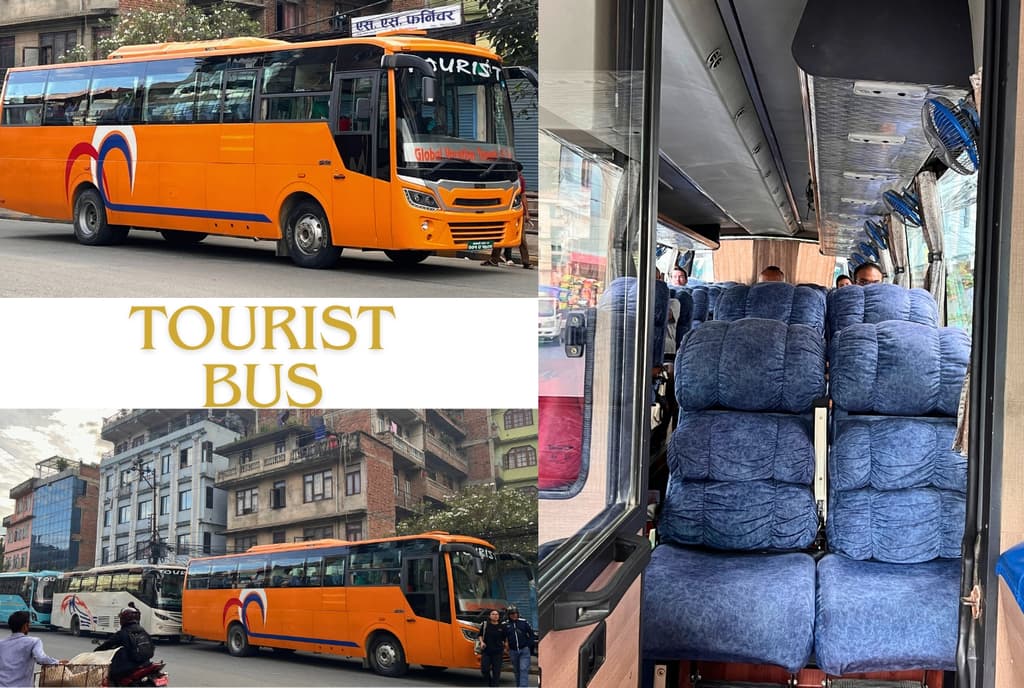
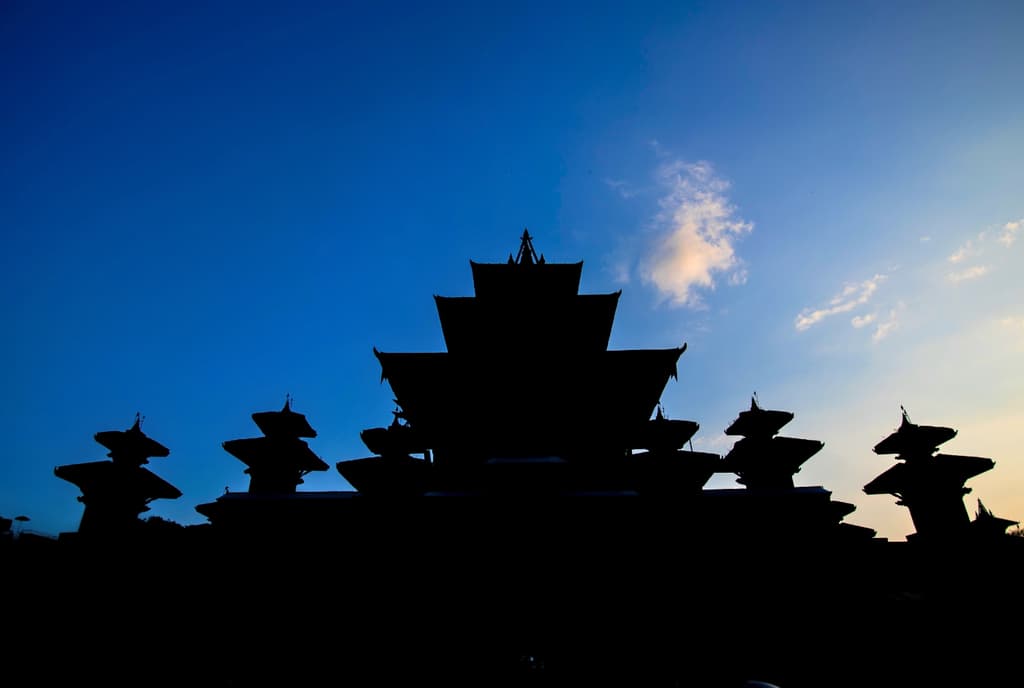
This day marks the end of your stay in Nepal. You will bid goodbye to friends and acquaintances made along the way and return with a ton of memories to cherish.
Nepal Hiking Team will be with you till the very end of the trip, as our representative picks you up from the hotel and drops you at the airport.
Remember us for your next trip to more places in Nepal, Bhutan, or Tibet.
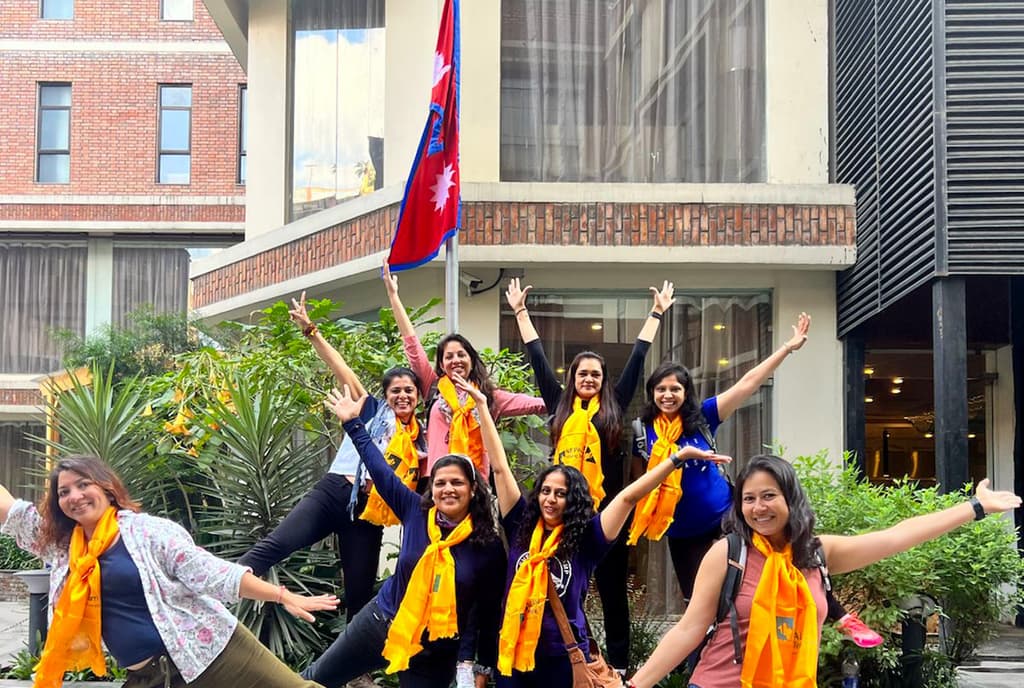
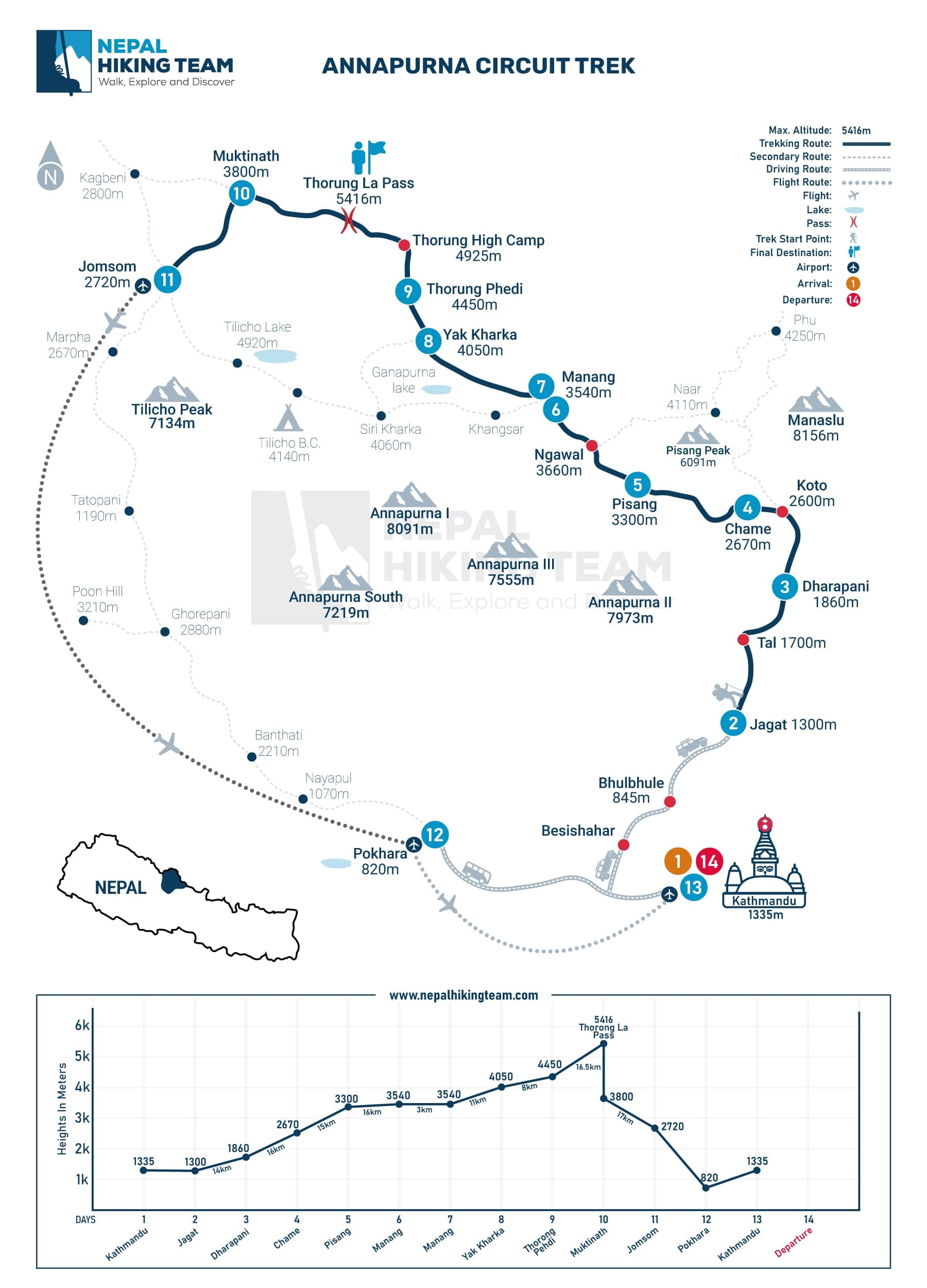
The total cost of the Annapurna Circuit depends on various factors, including trek length, group composition, the type of trekking agency (Local or International), and service preferences. Our 14-days Annapurna Circuit package features experienced local guides who know every hidden trail and cultural secret. Moreover, we provide essential permits, quality mountain lodges, and immersive experiences in traditional Himalayan villages.
We recommend bringing at least 25,000 to 35,000 NPR (approximately US$200 to $ 300) for personal expenses during your mountain adventure. This covers your cost for snacks (chocolates, dry fruits) at trekking trails, hot drinks, and artisanal bric-a-brac made by local Tamang and Gurung. As the remote locations require cash payments, proper preparation ensures smooth transactions throughout your 10-day Annapurna Trip.
Our dedicated team from NHT awaits your arrival at Kathmandu Airport, ready to escort you directly to your hotel. When your overall trip concludes, we make sure a stress-free departure with three-hour advance airport transfers. This way, you can focus entirely on creating memories instead of handling your transportation.
Your Annapurna Circuit trek begins with a scenic drive from Kathmandu to Jagat by private vehicle (car or jeep), passing through Nepal's stunning countryside. The return trip offers breathtaking aerial views during your flight from Jomsom to Pokhara over the Himalayas. However, if the weather disrupts flight schedules, our backup drive takes you through villages like Marpha, Ghasa, Tatopani, and Beni.
The final drive brings you back to Kathmandu through comfortable tourist bus transport. However, if you want a convenient transportation facility, you can take a flight from Kathmandu to Pokhara and vice versa for just $115 (one way).
We are delighted to confirm that our Annapurna Circuit departures are strategically scheduled during the finest trekking periods, ensuring you benefit from supportive weather for long days on the trail and the most rewarding, spectacular views. We focus on two premium seasons: Spring (March–May) & Autumn (October–November).
This predictable and dependable schedule remains steady for our 2026, 2027, and future itineraries, allowing you to plan this legendary trek with complete confidence well in advance.
For current group dates and available slots, please visit our [Fixed Departure Dates] page.
The season you choose for your Annapurna Circuit trek can significantly impact your overall experience. Here’s what you can expect in each season:
Spring (March to Late May): During springtime, the temperature ranges from 10°C to 20°C even at lower elevations. Trekkers can see rhododendron forests, creating stunning natural galleries along the route. Clear skies and stable weather provide excellent mountain views and comfortable trekking conditions. However, the trails will be busier as it is one of the most popular trekking seasons.
Autumn (September to November): This is one of the best times of the year to trek, with temperatures ranging from 10°C to 20°C and clear, open skies. The mountains are at their most stunning, and the season is made even more special by major festivals like Dashain and Tihar, which bring vibrant cultural experiences. Because of these ideal conditions, the trails and teahouses are often quite busy during this time.
Summer (June to August): The Monsoon season brings lush green landscapes and temperatures between 15°C and 25°C in lower areas. Waterfalls enable the vegetation to reach its most vibrant state, creating a luxuriant forest. Fewer trekkers mean quieter trails and more intimate mountain experiences. However, heavy rainfall creates muddy paths, and clouds often hide mountain peaks from view.
Winter (December to February): Winter offers peaceful trails and clear mountain views with lower elevation temperatures from 5°C to 15°C. However, extreme cold and heavy snow make crossing the Thorong La Pass very difficult. Many high-altitude teahouses close completely, limiting accommodation options for winter trekkers.
Manang serves as the ideal acclimatization pause during your trek, in Gandaki Pradesh within the protected Annapurna Conservation Area. This charming village is situated in an incredible landscape.
It has Tibet's autonomous region to the north, Mustang district to the west, Kaski to the south, and Lamjung to the east. You'll discover three remarkable monasteries here that showcase the region's deep spiritual heritage.
Braga Gompa is one of the main attractions in Manang, boasting over 300 years of spiritual significance. When you visit, you’ll find valuable items such as hand-carved Buddha statues, a golden Kangyur, and ancient relics. Nearby, Milarepa Cave Monastery holds stories about Milarepa, the famous 11th-century Tibetan yogi and poet, who is believed to have spent six years meditating there before reaching enlightenment.
Kicho Tal, or Ice Lake, is a great place to visit on your rest day in Manang. The hike there is about 10 to 12 kilometers and can be hard, but the views of the lake high up and the mountains around are worth it. In some seasons, the lake freezes and acts like a mirror, showing clear reflections of the peaks. Many people who like photography and adventure enjoy this walk.
Thorong La Pass (5416 m) is the highest point of the Annapurna Circuit trek. This high mountain crossing connects Manang and Mustang districts and offers the most beautiful views of the entire journey. Most trekkers cross this pass, starting from the Manang side, and travel clockwise from Dharapani to Muktinath, as it helps alleviate altitude sickness.
The climb up shows you amazing mountain views, including Annapurna II and IV, and Gangapurna peak. You'll also see Tilicho Peak, Pisang Peak, and Lamjung Himal creating a stunning backdrop as you go higher. The Chulu West and Chulu East peaks make the scenery even more dramatic as you approach the summit.
After you make it to the summit and start going down, completely new mountain views appear in front of you. Mount Dhaulagiri dominates the western sky, while Nilgiri, Hiunchuli, and Thapa peaks form beautiful shapes against the horizon. The pass sits right between Khatung Kang and Yakawa Kang peaks, giving you incredible views in every direction.
Chame is known as the bustling headquarters of Manang District, situated at an elevation of 2,670 meters. It is positioned perfectly 15-16 kilometers from Dharapani on your Annapurna Circuit journey. This village offers everything, including a comfortable guesthouse, well-stocked shops, and reliable medical facilities after days on mountain trails.
The Marsyangdi River flows directly through the center of Chame village. Trekkers can also enjoy breathtaking views of Annapurna II (7,937m) and Lamjung Himal (6,983m).
Chame perfectly balances mountain remoteness with essential comforts in dense forests and terraced fields. Surpassing this village, your trail continues toward Pisang, Manang, and the challenging Thorong La Pass at 5,416 meters.
The Annapurna Circuit with Tilicho Lake Trek is a 16-day trek that offers all trekkers an unforgettable experience. Along the way, you’ll get to visit Tilicho Lake, which is known as one of the highest lakes in the Himalayas and is known for its stunning beauty.
The trek features diverse landscapes, ranging from lush forests at lower elevations to dry, rocky areas at higher altitudes.
You will cross the Kali Gandaki Gorge, which is one of the deepest river valleys on Earth. Tilicho Lake, with its clear blue water, is also one of the largest high-altitude lakes you’ll find.
This trek is challenging yet rewarding, offering stunning mountain views and the opportunity to interact with local people and experience their culture. You’ll pass through various villages in the Annapurna region and visit the sacred site of Muktinath.
The most challenging part is crossing Thorong La Pass, which tests your strength and endurance. This journey offers a true adventure and a great sense of achievement once you reach the end.
Read our genuine feedback from past travelers with Nepal Hiking Team sourced from TripAdvisor, Google, Facebook, and Trustpilot.
I just did the Annapurna Circuit Trek for 14 days with Nepal Hiking Team, and this was one of the most rewarding experiences of my life.
From the responsiveness of the host Ganga Thapa / Balram Thapa to the care, guidance and support of the guides Aital, Buddhi and Sabeen, it was an incredible journey through the Himalayas and it was only possible because of Nepal Hiking Team.
I had a great time, the places they booked along the way were amazing, they treat you like a family member and that makes the experience even better that I had thought. I am definitely going to recommend them for anyone traveling to Nepal for any of these hikes/tours. Highly recommended.
 +
+ +
+ +
+
We've been back in Australia for 2 weeks now since our Annapurna Trek and still cant believe how lucky we were with our timing. Floods before we arrived then snow disrupting a lot of people's trekking plans the week after we finished.
I am reaching out to specifically thank you for putting our itinerary together and making our time in Nepal wonderful and stress-free. I would also like to congratulate you on your choice of employees.
Indra was the most fantastic guide. Fun, knowledgeable, easy to speak to and a very intune understanding of each of our groups expectations. Me and my husband Mark and I were the Mumma and Pappa of our group and Indra showed lots of patience when the Altitude became challenging, allowing me to linger behind and interact with the locals and animals and enjoy the scenery without feeling pressure to keep up with the younger ones. His ability to make everyone in our group was happy and well was fantastic. Please pass on our appreciation to him.
Sandip, our Assistant Guide ,was also a joy to walk with. Looking after us at meal times, sharing a joke, card games and some dancing, and under Indra's guidance will become a great Lead Guide.
I also have complete admiration for our Porters, Gulu, Binod and Rajan. They have the hardest job and greet us every morning with a smile, and then load all our gear daily again with a smile at every interaction please also pass on our gratitude.
Annapurna Circuit Trekking with Nepal Hiking Team was an incredible experience, one that created many once-in-a-lifetime memories.
The Annapurna Circuit trek was everything I could have hoped for: stunning vistas, daily views of the majestic Himalayas, quaint mountain-side villages, temples and prayer wheels. The people of Nepal are warm and welcoming. Our group of seven was expertly led by Nepal Hiking team lead guide Ganga Tamang, assistant guide Govinda Adhikari, and porters Ram Krishna, Karan, Saurab and Raju.
This was a wonderful competent team, and not once did I have any worries about our day-to-day activities or our safety, which was stressed by all. I highly recommend Nepal Hiking Team and would absolutely use them again if I visit Nepal again.
 +
+ +
+ +
+ +
+Our 14-day Annapurna Circuit trek was an unforgettable experience, truly the trip of a lifetime, thanks to our incredible guides and porters.
Our guides, Ganga and Govinda, worked tirelessly behind the scenes to ensure every detail was taken care of. They consistently found us the most comfortable teahouses and best possible dining options, all while adjusting our itinerary to fit our group’s needs and energy levels. Their thoughtful pacing and calm leadership helped us stay strong and positive throughout the journey.
Ganga’s deep experience and quiet confidence put us at ease, especially as we faced the challenges of altitude. Both guides shared invaluable insights into Nepali culture, traditions, and daily life, helping us connect more deeply with the people and places we encountered along the way.
We were also fortunate to have an outstanding team of porters, Ram Krishna, Karan, Saurab, and Raju, who carried our gear with incredible strength and grace, always greeting us with smiles and encouragement. We truly appreciated the moments we shared with them, from our friendly football matches along the trail to our acclimatisation hikes on rest days.
This was more than just a trek; it was a cultural and personal journey made special by the warmth, professionalism, and heart of our entire team. We are deeply grateful to Ganga, Govinda, and our porters for making this adventure one we will never forget.
We did the Classic Annapurna Circuit Trip with Nepal Hiking Team and our guide, Sam Tamang. From start to finish, it was a great experience.
Before we began, Sam messaged us to check what gear we had and suggested a few extra items for the weather, which turned out to be spot-on. During the trek, he was calm, organised, and always had things running smoothly. He managed meals, timing, and any changes in plan without stress, and somehow always knew when to add a bit of humour or when to give us space.
It was also clear that other guides really respected him. We often saw them asking him questions or coming to him to sort things out. He answered all our questions about the culture, history, and local life really well, and if he didn’t know something, he always came back later with the answer.
We were trekking with one porter too, who was great and worked so hard. He was younger and still learning English, so Sam helped guide him as well and kept everything running smoothly.
There was a tough day at High Camp where I wasn’t feeling great, and Sam gave just the right amount of support and advice to help me get over the pass with confidence. We always felt safe and looked after.
We’d happily recommend Nepal Hiking Team and especially Sam. He’s knowledgeable, kind, and makes sure the trek is enjoyable and well organised from start to finish.
Our safety and service record is as solid as gold, and we have been guiding people around the Annapurna Circuit for more than 17 years. Our local guides are licensed, highly experienced, and familiar with every corner of the trail- the green valleys and high passes.
Logistics, support, and acclimatization are all taken care of during the hike. All the itineraries are elastic: we adjust the walking hours, side hikes, and rest days to your pace and comfort level.
Pricing is established on day one. On the trail, you will know what all is included and will not face any surprise charges. Trekkers rate us highly on reliability, support, and their overall experience.
Our Annapurna Circuit package typically accommodates groups of between two and 10 people, with most groups consisting of eight people. Smaller groups will allow more support and a more comfortable atmosphere.
After booking, your trip is confirmed and guaranteed to proceed, even if no other person registers. In exceptional circumstances, such as strikes or natural disasters, we can provide an alternative date or route; however, your booking remains secure, and our team fully supports us.
Yes, as a solo traveler, you can join any of our group departures. If other trekkers do not book the same date, your trip will not be canceled. We offer guaranteed departures, and regardless of any unforeseen circumstances, you will receive full support throughout the trek.
There is also the benefit of joining a group and meeting other travelers, sharing the experience at a more affordable rate.
We also offer custom Annapurna Circuit tours for couples, families, or friends. These packages provide you with greater flexibility to choose your travel dates, speed, and route. When there are two or more of you, the cost is the same as our regular group departures. Group size is not restricted, and we shall strategize what suits you best.
Both treks follow the same path, offer the same services, and inhabit the same areas. The only factual change is that the 14-day trek begins with a drive from Kathmandu to Jagat on the first day and proceeds to Dharapani on the second day. The 12-day version bypasses all that and starts by driving to Dharapani on day one.
In any case, the usual 14-day Annapurna Circuit trek finishes in Jomsom. If you're pressed for time, the 12-day itinerary may be more suitable, as you can simply hop into a vehicle at Muktinath and ride to Pokhara.
The Classic Annapurna Circuit continues for four additional days beyond Muktinath. It then passes through Marpha, Ghasa, Tatopani, and Ghorepani (Poon Hill) and returns to Pokhara.
The 14-day Annapurna Circuit ends in Jomsom, where you can find a direct flight to Pokhara, eliminating the additional days of the Classic program.
All these itineraries can be adjusted to suit your time, interests, and budget. Custom gigs are considered private trips; therefore, group departures are not applicable. Need some more time in Pokhara or Kathmandu? That we can take care of, at a small charge.
Reservations are simple: choose your dates, fill out our form, and leave a down payment on your card. After we receive the money, we will send you a confirmation email. Anyone wishing to pay later can simply select the 'Book Now and Pay Later' option, and we will forward a payment link to them.
You can settle the remainder of the balance in Kathmandu before the trek by card, in cash, or via a rapid bank transfer.
The 20% deposit is non-refundable; however, if you cancel your Annapurna Circuit Trek, we will hold the full amount as a credit towards a future trip. This does not expire and can be utilized at any moment.
Simply send us an email, and we will take care of the rest. Before booking, we suggest reading our entire cancellation policy.
Yes, most tourists can obtain a visa on arrival at Tribhuvan International Airport in Kathmandu. You should have a valid passport with at least six months' validity, a passport-sized photograph, and either cash or a credit card to pay the visa fee.
Certain nationalities may require an advance application, and we recommend consulting the nearest Nepalese embassy if you are unsure.
Yes, we offer airport pick-up and drop-off services. Upon arrival, a representative from the Nepal Hiking Team will be waiting at the airport entrance to greet you and escort you to your hotel.
Your transfer back to the airport for your return trip will also be arranged by us after your trip.
We have a 3-star hotel in Kathmandu, such as the Woodapple Hotel and Spa, located in Thamel. You will be staying in Pokhara, close to Lakeside overlooking Phewa Lake and the mountains.
Note: The hotel can be upgraded to 4-star, 5-star, or luxury status upon request, at an additional cost.
Yes, you can leave behind any things you do not require on the trek at your hotel in Kathmandu. Your luggage will be under the care of the hotel staff and will be returned to you upon your departure. There is no charge to this service.
An additional night in Kathmandu costs USD 45 for a single room and USD 50 for a twin or double room, including breakfast and taxes.
At Pokhara, the prices are $40 per single room and $45 per twin or double room. We would be happy to accommodate you if you wish to arrive earlier or stay longer. Please let us know.
The briefing before the trek will take place at your hotel, typically on the day before the trek begins. You will see your guide, discuss the Annapurna Circuit itinerary, and check your equipment. We will supply you with trekking gears, which consist of a duffel bag, a sleeping bag, a down jacket, a map, and a T-shirt.
We will also inform you about the trail and weather conditions in Annapurna and collect your passport, a copy of your insurance, and any outstanding balance payment, if applicable.
For the Annapurna Circuit Trek, transfers are included. Transfers to and from the airport in Kathmandu are done by a privately hired car. It's a 6-hour drive by private vehicle to Besisahar, followed by a 4-hour journey by private jeep to Syange.
Once the trek is over, you will fly back to Pokhara (fare and tax inclusive) and be brought back to Kathmandu by tourist bus. All cars are comfortable, reliable, and suitable for the mountain roads.
Yes, when you return to Kathmandu from Pokhara, you can fly back instead of using the tourist bus. The flight duration is approximately 25 minutes, and the cost is $115 per person. Although bus travel is included in our package, we can also upgrade to a flight upon special request.
The Annapurna Circuit Trek is described as a moderate trek that spans 10 to 11 days of trekking on varied terrain. You will be walking 6 to 8 hours a day, usually on steep uphill and downhill trails. Thorong La Pass is the most challenging part of the trek; it is the highest point at 5,416 meters.
Altitude sickness (AMS) may be an issue at higher altitudes; however, the program allows for a complete acclimatization day at Manang to minimize the possibility.
Our typical itinerary is around 113 kilometers (approximately 70 miles) between Dharapani and Jomsom. The distances covered on a daily basis are 8-17 kilometers, and the highest point is Thorong La Pass (5,416m).
Our guides are trained and are experienced in long-distance trekking in high altitudes on the Annapurna Circuit. They bring a first aid kit and an oximeter to regularly check your oxygen levels. They are taught to look out for early indications of altitude sickness and will slow down, rest, or go down accordingly.
Our trekking schedule is leisurely and has an acclimatisation day at Manang. The teahouses are thoroughly chosen in terms of hygiene and safety. In the event of a severe emergency, we organize a prompt response or a helicopter rescue.
Spring (March to May) and autumn (September to November) are the best seasons to plan the Annapurna Circuit Trek, as the weather is generally stable, the skies are crystal clear, and the views of the majestic mountains are at their most spectacular.
Important Notice: Trekking in summer and winter is not advisable. A lot of rain, landslides, slippery paths, and leeches are present in the summer. The route is unsafe in winter and is usually closed by deep snow and impassable high passes, including Thorong La.
For the best experience and safety, schedule your trek for the spring or autumn.
Vaccinations are not necessary, although some trekkers get inoculated, such as against rabies, as a precautionary measure due to the presence of stray dogs in rural regions. It is recommended to check the current recommendations of the CDC.
Yes, travel insurance is mandatory on the Annapurna Circuit trek. They should be high-altitude rescue and helicopter evacuation above 5,400 m, trip cancellation, and baggage loss insurance in your policy.
You may refer to worldwide providers such as Genki Traveler, AXA, Allianz, or World Nomads, or select any plan that suits these requirements.
We suggest commencing physical training 4-6 weeks before the trek. Pay attention to cardio activities, such as hiking, brisk walking, cycling, or stair climbing, to train your endurance during long trekking days. It can be simulated by doing one longer hike per week, carrying a backpack.
Leg and core strength training will ensure that the uphill and downhill portions will be easier. Train on an uneven surface, and wear your hiking boots before the day to ensure you don't experience discomfort during the trail.
Yes, we provide the necessary trekking equipment for your Annapurna Circuit Hike. This comprises a -20°C down jacket, a 70L duffle bag, and a four-season sleeping bag, which should be returned at the end of the trek.
You will also receive a Nepal Hiking Team T-shirt, cap, Annapurna Circuit map, and a certificate of trip completion, which records the highest elevation reached.
The trek would be suitable with a 20-30L day pack. You will bring essentials such as water, snacks, a camera, and personal items, and the porter will carry your main duffel bag.
Each trekker places their luggage in the hands of one porter, but the total weight of their luggage should not exceed 25 kg. Your duffel bag should weigh between 10 and 12.5 kg (22-27 lbs).
Pack as lightly as possible, layer intelligently. Take moisture-wicking baselayers, a fleece or down mid-layer, and a hardshell jacket and pants. Include sturdy hiking boots, trekking poles, gloves, a sun hat, a warm hat, and sunglasses. Bring a head lamp, water bottles, and simple toiletries.
As the weather is highly variable, please be prepared for both hot and cold conditions. Have a look at our full packing list.
Teahouses are used as accommodation, which are clean and straightforward lodges operated by the local families. The majority of them provide beds, mattresses, blankets, and shared bathrooms in twin-sharing rooms. The toilets are western-style with the exception of higher altitudes such as Yak Kharka and Thorong Phedi.
Most stops offer hot showers, which may be available at an additional cost. There is no heating of rooms, but dining areas are warm with a wood stove.
Yes, the Annapurna Circuit is mostly covered by mobile networks, and Wi-Fi is Available in most teahouses, although it may be payable.
To have a better connection, you can purchase a local SIM card (NTC or NCELL) in Kathmandu or at the airport and buy a data package. They are more reliable, up to Pisang, and a cheaper option than paying to use Wi-Fi at every stop.
Yes, every teahouse has electricity, allowing you to charge your devices at a small fee (US$2-3 per device). The supply can be scarce during peak seasons or due to power issues, which is why it is highly advisable to bring a power bank.
Note: Nepal has 2-pin and 3-pin plugs with a 220-240V output, and it is advisable to bring a universal adapter.
In the Annapurna Circuit, most teahouses provide twin-sharing rooms. Single rooms are available at an extra cost but are not always available at higher-altitude stops, such as Yak Kharka or Thorong Phedi, due to limited space.
If you are a solo female traveler, we guarantee that you will be matched with another female or have a separate room (if available). You won't be asked to share a room with a male trekker.
Teahouses offer a variety of freshly cooked dishes, including Nepali dal bhat, momos, noodles, soups, pasta, and other Indian and continental cuisine. Breakfast options include chapati, eggs, pancakes, potatoes, muesli, and Tibetan bread. At every stop, trekkers are allowed to select meals from a menu.
Special notice: There are vegetarian, vegan, and gluten-free options. If you have food restrictions or allergies, please notify us beforehand or inform your guide during the trek; they will assist in organizing with the kitchen.
Yes, there is water to drink all the way. It is possible to replenish your bottles at guesthouses or safe water stations along the road. In certain sections of the Annapurna region (Annapurna Sanctuary), the use of bottled water has been prohibited, and we also discourage its use due to the plastic waste it creates.
To have a sustainable trek, bring a reusable water bottle and purification tablets, which our guides carry and can use in case of an emergency. The target is to consume 3 to 4 liters of water daily to stay hydrated.
The trek can be trekked by withdrawing or exchanging Nepalese Rupees in Kathmandu or Pokhara. We suggest carrying around NPR 25,000 to cover your expenses, such as hot showers, Wi-Fi, snacks, and charging. The availability of ATMs in Chame, Manang, Muktinath, and Jomsom is not very reliable, and they are sometimes even out of order; therefore, it is better not to rely on them.
However, tipping is not required, yet it is a standard and welcome custom in Nepal. Most trekkers tip the guide and porter to show their appreciation for the services they provided during the trek.
It is not a fixed amount, but rather it depends on your experience and level of satisfaction. The tips may be paid in Nepali Rupees (NRs) and US Dollars ($).